令和5年度 「今週の朝礼」 The Morning Assembly Speeches of The Week 2023-24
更新日:2024年3月14日
令和6年3月 March, 2024
令和6年3月11日(月曜日) 「信号機の色のように」 養護教諭M.M.先生 Monday, March 11th, 2024 "Like The Colors of A Traffic Lights"
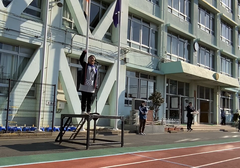
保健室のM先生
皆さん、おはようございます。
では、話を始める前に、皆さんに質問があります。信号機は、青が先かな? 赤が先かな?どっちだと思いますか。(赤? 青?) 実は、信号機は赤から始まっています。縦型の信号は上が赤、下が青になっています。車の信号機も右が赤になっています。
どうして私は信号機は赤が先だなんて話したのかというと、みんなが行動するときに、信号機のことを思い浮かべてほしいなと思ったからです。何か行動するとき、「あっ、楽しそう!」「面白そう!」と、ぱっと動くのはとても素敵なことですが、行動する前に信号機を思い浮かべて、一回止まって考えてほしいと思っています。
車用の信号を思い出してみてください。赤の次は何色が来ますか? 黄色ですね。黄色はどういう意味でしょう。(「注意!」)そうですね。まず赤で1回止まって、黄色で考えてほしいんです。「これ、面白そうだな。やってみよう!」と言って行動するのは素敵なことですが、そのことによって誰かが傷ついたりしないかなとか、これをやったら誰かがけがをしたりしないかな?と考えてほしいと思っています。そして、最後の青。青はどんな意味ですか?(「渡っていいよ。」)そうです。行動してください。最初赤で止まって、黄色で考える。そして青で行動する。そうすると、いろいろないやなことが減ると思います。例えば、お友達とじゃれ合っているうちにけんかになってしまった。そして、けがしてしまう。そういうことが少なくなります。
私は以前中学校に勤めていたときにも、中学生に同じ話をしました。相手がいて、気持ちがあります。みんながそれを考えてくれると、みんながとっても過ごしやすくなります。皆さんこれから進級して、学年が一つ上がりますね。6年生は中学生になります。これからいろいろなことがやれるようになりますが、今のお話をしっかり覚えておいてくれると嬉しいなと思います。これでお話を終わります。
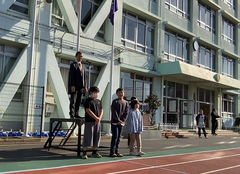
5年生代表
Good morning, everyone.
Before we begin, I have a question for you. Regarding traffic lights, which color comes first: green or red? (Red? green?) Traffic lights start with red. In vertical traffic signals, the top light is red, and the bottom is green. Even in car traffic lights, the rightmost light is red.
Now, let me explain why I mentioned the order of traffic lights. When you're about to take action, visualize a traffic light. It's wonderful to act at once when something seems fun or interesting, "Oh, that looks exciting!" But pause and think about the traffic light before you act. Consider stopping for a moment and reflecting.
Think about the traffic light for cars. What color comes after red? Yellow, right? What does yellow mean? ("Caution!") Exactly. First, stop at red, then think during yellow. It's great to say, "This seems interesting; let's try it!" But I also want you to consider whether your actions might hurt someone or cause an accident. And finally, green. What does green mean? ("You can go.”) Correct. Take action. Start with red, think during yellow, and then act during green. This approach can reduce unpleasant incidents. For example, imagine playfully wrestling with a friend and accidentally getting hurt. By following this process, such situations become less frequent.
I shared the same story with the students while working at a middle school. There's always someone else involved with feelings. If everyone considers this, it makes life more pleasant for all. As you move up to the next grade, remember this. Sixth graders will become middle school students. You'll have more opportunities, but I hope you remember this lesson.
That's all for today. Thank you for listening.
令和6年3月4日(月曜日) 「目標に向かって頑張る力」 白石副校長 Monday, March 4th, 2024 "The Power for Your Goals" by Vice Principal Shiraishi
大変良く話を聞いています
みなさん、昇降口にかざってある大谷翔平選手から送られてきたグローブをみましたか?
2月の学校だよりにこのグローブのことを先生は、保護者や地域の皆様に説明をしました。みなさんは1月に大谷選手に関する授業をして、感謝の写真をとりましたね。グローブと一緒に写真が飾ってありますが、この写真は大谷選手に送りました。
このグローブは「夢を与え、勇気づけるためのシンボル」として位置付けられていて、
シンプルに野球の普及と振興を願っているだけでなく、子供たちの夢と希望の応援につながる、大きな意義があります。これからも、飾っていますから、大事にしてください。
みなさんが自分の夢をもち、それを実現するために必要な力を育むことが小学校生活の中で目指す、大切な目標となっています。その目標を達成するために、先生たちは、自らの考えや行動を自分自身で振り返り、調整する力やしなやかでへこたれない心の強さ、立ち直る力を育てたいと考えています。
ですから、みなさんの主体性を育てたいと「自分の行動を自分で決めてほしい」と学校目標の自立を大切にしていきましょうと繰り返し話をしてきました。
どうでしょうか。
自分の行動を自分で決めてほしい というのは、自分の目標にむけて何をすべきか考えて行動してほしいということです。自分の夢や希望のために何を頑張るのか、それを考えて行動してほしいということです。
夢や希望というのは、遠い将来のことだと考えて、あまり実感がともなわない人もいると思いますが、今のこの小学校生活では一つ一つゆっくりとできることを増やしていって、将来の夢を見つけたり、こうなりたい、こういう人になりたいという気持ちを育てたりしていってほしいと思います。
そのために、今の学校生活の中で、自分で決めて行動することをチャレンジし続けていってほしいです。
では、毎週 朝会で今週の目標です。と、みなさんに言っていますね。これは、みなさんが 生活の中でいろいろと気を付けることで学校生活を幸せに過ごせるようにという目標のために話をしています。
先週まで、あいさつをきちんとしようという目標をたてていますが、それは、みんなが自分からあいさつができるようになってほしい、自分からあいさつをする気持ちよさを感じて、できるようになってほしいと思って目標にしているのです。みんなが当たり前に気持ちよく挨拶をすることができるようになったとき、あいさつをしようという目標はなくなると思います。
「ときまもり」時間を守って学校生活をおくりましょう。という目標を朝会でも何度も言われていたと思いますが、これも、「そろそろ座る?」とみんなで声を掛け合って、自分たちで時間を守ることができるようになったときは、チャイムをなしにできるかもしれません。
目標に向かって、やらされているのではなく、自分で行動をえらんでできるようになってほしい、と思います。
白石副校長
Have you seen the gloves sent by Shohei Ohtani, displayed near the entrance? I explained the gloves to parents and the local community in the February school newsletter. You all had a lesson about Ohtani in January and took photos with the gloves. We sent them to Ohtani.
The gloves are a 'symbol that inspires dreams and courage.' They aim to promote and popularize baseball and holds significant meaning in supporting children's dreams and hopes. Please continue to cherish them as they displayed.
Having your dreams and nurturing the necessary skills to achieve them is an important goal during elementary school life. To accomplish this goal, teachers aim to develop your ability to reflect on your thoughts and actions, cultivate resilience, and bounce back from challenges.
Therefore, we repeatedly emphasize the importance of independence and decision-making by saying, 'We want you to decide your actions for yourselves.' How does that sound?
'Deciding your actions for yourselves' means thinking about what you should do to achieve your goals. Even though dreams and hopes may feel distant for some, especially when considering the future, I encourage you to gradually explore what you can do in your current elementary school life. Discover your dreams, visualize who you want to become, and work towards those aspirations.
To achieve this, keep challenging yourself to make decisions and take action during your school life.
Now, during our weekly morning assemblies, we tell you the goals for the week. It serves the purpose of helping you lead a happy school life by paying attention to various aspects.
Last week, our goal was to greet each other appropriately. We set this goal because we want everyone to be able to initiate greetings, experience the joy of greeting others, and eventually reach a point where greeting becomes second nature. When everyone can greet comfortably, the specific goal of greeting will no longer be necessary.
Another goal we've emphasized during morning assemblies is to manage our time ('tokimamori'). It shows progress towards this goal when you all can remind each other to sit down without needing a chime. Ultimately, we hope you'll be able to make choices and take action independently rather than feeling compelled to do so.
Keep moving towards your goals, and remember that your actions matter.
令和6年2月 February, 2024
令和6年2月26日(月曜日) 「私たちの生活を支えてくれている人」 6年担任M.K.先生
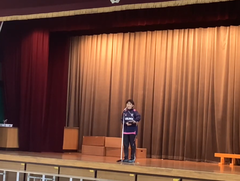
M先生
6年担任のMです。私は、去年の4月にこの学校に来ました。もうすぐ、1年が過ぎようとしています。この学校に来たときに、校舎はとても古いんだけれど、とってもきれいな学校だなという印象を受けました。もちろん、みんなが掃除を頑張ってくれているからなのですが、実は主事さんが朝、とても早くから掃除をしてくれています。皆のために毎日、毎日、隅から隅まで、とてもきれいにしてくれています。ある主事さんは、廊下を掃除機をかけて埃がないように、ある主事さんは階段を掃除してくれています。それから、窓の桟をきれいにしてくれています。それから、今日はこれから暖かくなるので暖房は入っていませんが、皆が集まるときに暖房をかけて体育館を暖めてくれています。暑い夏は冷房を入れてくれています。皆が来たときに、教室の窓が開いているのに気がつきますか。新鮮な空気が教室に入っていると思います。それも、主事さんが朝早くから、全部の教室を回って、窓を開けてくれているからです。主事さん方は、みんなが気持ちよく生活できるようにとやってくれているそうです。
さあ、皆の周りを見渡したときに、皆のために何かをしてくれている人はいますか? あと一ヶ月で新しい学年になります。今年一年みんなのことを支えてくれた人が周りにいると思いますので、探してみてください。その人たちに「ありがとう」と伝えられるといいなと思います。ぜひ、伝えてみてください。
これでお話を終わります。
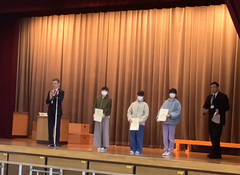
表彰も行われました
I am M, a homeroom teacher for the 6th grade. I arrived at this school in April of last year. Soon, it will be a year since I came here. When I first came to this school, the building was quite old, but it left a strong impression as a beautiful school. Of course, everyone's hard work in keeping it clean contributes to this, but there’s more to it. In reality, the janitors diligently clean early in the morning. Every day, they meticulously clean every nook and cranny for all of us. One janitor vacuums the hallways to ensure there is no dust, while another takes care of the stairs. They also keep the window sills clean. Today, since it's getting warmer, the heating isn't turned on, but when everyone gathers, they warm up the gym for us. During scorching summers, they make sure the air conditioning is working. Have you noticed that, when everyone arrives, the classroom windows are open? I believe it's because the janitors go to each classroom early in the morning and open the windows. These janitors are dedicated to ensuring that everyone can live comfortably.
Now, take a moment to look around you. As we approach the new school year in just one month, there are people who have supported all of you throughout this year. I encourage you to find those individuals and express your gratitude to them. Let them know how much you appreciate their efforts.
Thank you for listening.
令和6年2月19日(月曜日)「アンパンマンの頭の重さは?」 5年担任T.C.先生
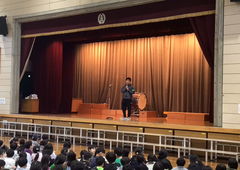
T先生
5年2組の担任のTです。今日は、あるアニメについてお話しします。
皆さん、アンパンマンを見たことがありますか? アンパンマンを見ていると、バタコさんがアンパンマンの顔を投げるシーンがありますね。あのとき、私は一つ疑問に思いました。アンパンマンの頭は重そうではないか? それで、私は調べてみると、皆さんが勉強している算数や理科の知識を使って、アンパンマンの頭の重さを調べた人がいました。
では、ここでクイズです。アンパンマンの身長が160センチくらいだとすると、アンパンマンの頭の重さはどれくらいでしょうか? 選択肢は3つです。1,1年生二人分の重さ。2,1年生4人分の重さ。3,1年生6人分の重さ。さあ、どれだと思いますか。10秒考えてください。
答えは、3,1年生6人分です。実際調べると、アンパンマンの頭の重さは94キロあるそうです。私も知ってびっくりしました。
こんなふうに、日常で不思議に思ったことを、皆さんが勉強していることを使って解決できるんだなとびっくりしました。だから、自分の好きな勉強に一生懸命取り組んで、何か気になったことがあったら、それを生かして解決してみてほしいなと思います。
これでお話を終わります。
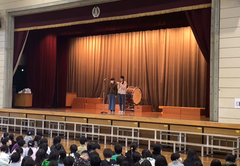
代表委員からお知らせ
Hello, I'm T, the homeroom teacher 5-2.
Today, I'd like to talk about a particular anime.
Have you all seen "Anpanman?" When watching "Anpanman," you'll notice a scene where Batako-san throws Anpanman's face. At that moment, I had a question: Doesn't Anpanman's head seem heavy?
So, I researched and found someone who used math and science knowledge to determine the weight of Anpanman's head. Here's a quiz: If Anpanman is around 160 centimeters tall, how heavy do you think his head is? You have three options:
1. The weight of two first graders.
2. The weight of four first graders.
3. The weight of six first graders.
Please take 10 seconds to think about it.
The answer is 3, equivalent to the weight of six first graders. Anpanman's head weighs 94 kilograms! Quite surprising, isn't it?
It's fascinating how we can use our curiosity and the knowledge we learn in subjects like math and science to solve everyday questions. So, I encourage you to dive into your favorite subjects and apply what you've learned to explore any questions that pique your interest.
That's all. Thank you for listening.
令和6年2月12日(火曜日) 「節分の5色の鬼」 3年担任H.T.先生
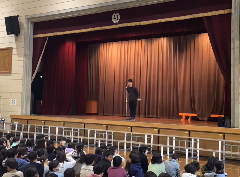
H先生
皆さん、おはようございます。
今日は、私が、10日ほど前の、2月3日節分についてお話します。節分の日に、豆まきをした人はいますか? 節分の豆まきですが、季節が変わるときに、「邪気」という悪いものが入ってこないように、邪気を鬼に見立てて、豆をまいて追い払おうとしたのが始まりです。
さて、ここで問題です。節分の鬼と言えば、赤鬼が有名ですが、実は鬼には5色の鬼がいるそうです。赤鬼、青鬼、黄鬼、緑鬼…。残りもう一つは、何鬼でしょうか?5秒間考えてみてください。正解は、「黒鬼」です。
この5色の鬼にはそれぞれ性格があります。赤鬼は「何でもほしい、あれもほしい、これもほしい。」の欲しがり鬼。青色は人の悪口を言ったりする怒りんぼ鬼。黄色は「僕はこうしたい、ああしたい」というわがまま鬼。緑色は「ああ、面倒くさいなあ。」というなまけ鬼。そして、黒は「えー、僕じゃないもん。あの人のせいだよ!」の人のせい鬼。
さあ、この5色の鬼。みんなの心の中にはいないでしょうか? 大丈夫ですか? 今、心の中に鬼はいないよ、っていう人も、みんなの心の中にはこの鬼が潜んでいるそうなので、豆まきでは追い払えない心の鬼を自分でしっかりと追い払って、残りの2月3月を過ごせるようにしましょう。
今日は節分の5色の鬼についてのお話でした。
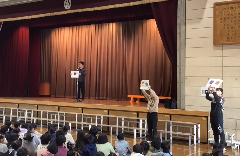
5色の鬼?
2月5日(月曜日) 「主体的である 〜私たちに号令は必要か?〜」 川中子校長
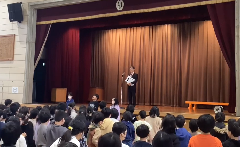
6年生代表あいさつ
おはようございます。2月になりました。一昨日は節分。そして、昨日は立春でしたね。皆さんは豆まきはしましたか。暦の上では春が来たことになっていますが、今日は一段と寒い朝になりました。
私はここ数年ずっと「主体的である」ということについて考えています。「主体的である」っていうのは、「誰かに言われてやる」のではなく、「自分のいうこと・やることを、自分自身で選んで決める」ということと、「自分で決めてやったことに対して、うまく行ってもいかなくても、決して言い訳をしない、人のせいにしない」ということですね。今日は、なぜ主体的に生きることが大事なのかという話をします。
では、まず、実験をやってみましょう。後で、どんな気持ちがしたか話してもらいます。それでは皆さん、立ってください。それでは、皆さん、その場で目をつぶったまま、ゆっくり3回回ってみてください。私が「目を開けて」というまで目は閉じたままにしておいてください。いいですか。それでは、どうぞ。はい。目を開けてください。どっちを向いていますか? それでは、列が乱れてしまったので、整列してみましょう。
気を付け!
前へならえ!
直れ!
休め!
気を付け!
もう一度、前へならえ!
直れ!
はい、これで実験は終わりです。静かに腰を下ろしてください。
それでは、皆さんに聞きます。今、整列するとき、私は号令をかけました。その号令に合わせて、みんなは動きましたね。今、私から号令をかけられたとき、どんな気持ちがしましたか。何を思いましたか。自分の気持ちを振り返って、ちょっと近くの人と話してみてください。どんな気持ちがしたか、と。
はい、どんな気持ちがしたか教えてくれる人はいますか。
(いつもと違う感じで)びっくりした 何も感じなかった
皆さん、今、私がかけた号令は、これまで学校で当たり前に行われてきたものです。私は、ずっと主体性のことを考えていたら、この「前へならえ!」なんていう号令は必要ないのではないかと思うようになりました。この号令は、もともと、どんな時に使われたものか知っていますか。実は、兵隊の訓練の時に使われたものなのです。兵隊というのは、戦争に行って、敵を殺す人たちです。戦争をする人は、自分では戦場に行かないで、兵隊に行って戦わせるのです。兵隊が余計なことは考えず、言うことをよくきくようにするために、言葉や暴力で脅して、従わせるのです。明治の世になって、日本は欧米の国々と対等にやっていくために、兵隊を鍛えて、戦争に強い国を作ろうとしました。学校では、子どもたちが将来立派な兵隊になれるように、軍隊式の訓練や号令を取り入れていました。そのうちの一つが、さっき皆さんにかけた号令です。学校では当たり前になってしまっていて、普段誰も不思議に思わなくなっていますが、今、学校でこのような号令をかけている国は、日本以外にほとんどありません。人から言われたことに何も考えずに黙って従っているだけだと、いつか皆さんも兵隊にさせられて、戦争しに行かされてしまうかもしれません。ロシアとウクライナの戦争が始まって、この2月で丸2年になります。ウクライナでは大人の男の人は、国からでることは許されず、みんな兵隊にさせられています。去年10月に始まったイスラエル・ガザ戦争でも、ガザ地区の死者はすでに25000人を超えているそうです。戦争は一度始めてしまうと、やめられなくなってしまうのです。だから、絶対に戦争は初めてはいけないのです。
さて、皆さん。主体的であることを目指す三吾小で、こんな号令は必要ですか? たくさんの人が狭いところに集まるとき、みんなが好き勝手にばらばらになっていたら、後から来た人が入れなくなってしまうかもしれません。だから、こうやって集まったときは、整列をした方がいいな、と自分で考えて、列を整えればいいのです。号令なんて掛けられなくても、みんな、そんなことはできますよね? 何が正しいのか、自分は何をするべきなのか、自ら学び、考え、行動する人になりましょう。
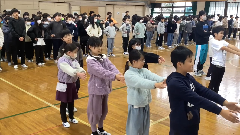
「前へならえ!」
Good morning. It's February. The day before yesterday was the end of winter (Setsubun), and yesterday was the beginning of spring (Risshun). Although the calendar says spring has arrived, today is a freezing morning; it'll snow in the afternoon.
For the past few years, I've been thinking about being "proactive." Being proactive means making choices and decisions about what you say and do based on your own preferences rather than doing something just because someone else told you to. It also means taking responsibility for your decisions, whether they lead to success or failure, without making excuses or blaming others.
Now, let's conduct a little experiment. Later, I'll ask you how you felt during the process. Everyone, please stand up. Now, with your eyes closed, slowly turn around three times. Keep your eyes closed until I say, "Open your eyes." Ready? Go ahead. Okay, open your eyes. Which direction are you facing? Now that our line is disorganized let's get back in order.
Attention! Fall in! Straighten up! At ease! Attention! Once more, fall in! Straighten up!
Alright, the experiment is over. Please sit down quietly.
Now, I'd like to hear from you. When I gave the command for alignment, everyone followed it. How did you feel when I gave you that command? What thoughts crossed your mind? Take a moment to reflect on your feelings and discuss them briefly with someone nearby.
Yes, is there anyone willing to share feelings? (Surprised, felt nothing, etc.)
You see, the command I just gave "Fall in!" has been a common practice in schools for a long time. However, as I've been thinking about being proactive, I've questioned whether such commands are necessary. Do you know where this command initially came from? It was used during military training. Soldiers sent to war to kill enemies don't make their own decisions. Instead, they must follow orders without questioning, often through verbal commands or violence. In the Meiji era, Japan aimed to compete equally with Western countries and thus focused on training soldiers to build a strong military. Schools incorporated military-style training and commands to prepare children to become respectable soldiers. The command I just gave you was one of those military-style orders. While it has become commonplace in schools, few countries other than Japan use such commands. Suppose we mindlessly follow what others tell us without thinking. In that case, we might be forced into becoming soldiers and sent off to war someday.
As we approach the two-year mark since the start of the Russo-Ukrainian War, let's remember that in Ukraine, adult men are not allowed to leave the country; they are all conscripted into the military. Similarly, the Israel-Gaza conflict began last October, and the death toll in Gaza has already exceeded 25,000. Once war begins, it becomes difficult to stop. That's why we must never initiate war in the first place.
Now, my question to you all at San-Azu Elementary School, where we strive to be proactive, is: Do we need commands like this? When many people gather in a confined space, if everyone acts independently, chaos may prevent latecomers from joining. So, when we gather like this, it's better to think for ourselves and align ourselves without a command. Can't we do that without being ordered? Let's be a person who learns, thinks, and acts independently, considering what's right and what we should do.
令和6年1月 January, 2024
令和6年1月29日(月曜日) 「ルール、マナーの大切さ」 算数・O.S.先生 Monday, January 29th, 2024 "How Important Rules and Manners Are" by Mr. O. S., a math teacher
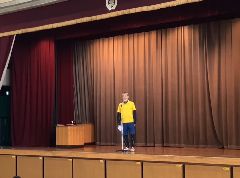
O先生
おはようございます。今日は、三吾あいことばのお話をします。
みんな、「右静か」って知っていますか? 「左」しずかじゃだめなのかな? 右「走り」はだめだよね。ぶつかってしまうから危ないです。けがしてしまうかもしれない。「左」しずかなら、良いのではないですか? どうしてでしょうね。
「右」しずかでも「左」しずかでも、本当はどちらでも良いのかもしれないけれど、この学校では右を歩きましょう、というふうに決めたんです。自動車も、国によって、右を走る国と左を走る国がありますが、好きな方を走って良かったら危ないです。三吾小学校は皆さんの他にも、先生や主事さん方を入れたら600人くらいの人がいて、好きな方を歩いていたら、どんなに静かに歩いていてもぶつかったり、歩きにくかったりするでしょう。だから、右側を歩きましょう、って、決めたんですね。決めたのです。決めたから「右しずか」になるのです。体育館から出るときは、4列で出た方がスムーズに出られるから右側だけでない歩き方をしています。そういう風に決めたからです。
こうやって多くの人数で生活したりするときには、ルールとかマナーが大切になってきますね。自分でやりたいことを何でもやっていいのかと考えると、違うと思うのです。自ら学び、行動する人になってほしいのですが、自ら学び行動する人は、思いやりをもち共に生きる人でなければいけないんじゃないかなと、私は強く思っています。皆さんはどうでしょうか。そのような人を目指して生活していますか。
私の話はこれで終わります。
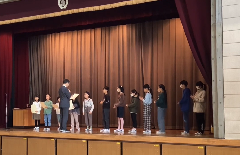
表彰も行われました
Good morning. Today, I will talk about the San-Azu Watchwords. Do you all know "Migi Shizuka (Walk on the Right)"? Is "Hidari Shizuka (Walk on the Left)" wrong? Running on the right is dangerous because you might bump into someone and get hurt. Wouldn't it be better to be "Left Quiet"? You may wonder why that is. Even if it's okay to be "Right" or "Left," we decided to walk on the right side. Cars also run on the right or left depending on the country, but it's dangerous to run on the side you like. There are about 600 people at San-Azu Elementary School, including teachers and staff, so even if you only walk quietly, you might bump into someone or find it difficult to walk if you walk on the side you like. That's why we decided to walk on the right side. We decided. That's why it's "Walk on the Right". When we leave the gym, we walk in a way that is not just on the right side because leaving in four rows is smoother. When you live with many people like this, rules and manners become important. I don't think it's okay to do whatever you want. I want you to be a person who learns and acts independently. Still, I firmly believe that a person who learns and acts independently must be a person who lives together with empathy. What about you? Are you trying to live like such a person? That's all. Thank you for listening.
令和6年1月22日(月曜日) 「長距離走」 4年担任Y.H.先生 Monday, January 22nd, 2024 "The Long-Distance Running" by Ms. Y. H., a fourth-grade teacher
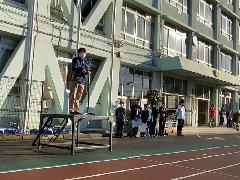
Y先生
冬休みが明けて、もうすぐで2週間が経ちました。先生は冬休み中に楽しみにしているものがあって、今回の冬休みもそれを楽しむことができました。それは、駅伝を見ることです。簡単に言うと、マラソンのリレーのようなもので、その中でも特に有名な箱根駅伝では、東京都の大手町から神奈川県の箱根まで100km以上の距離を5人の選手が走り、その往復をして競争をします。
ただ、先生は長い距離を走るのがあまり得意ではありません。そこで、長い距離を走るときのコツを調べてみました。
(1)背筋を伸ばして走る。走る時も、まっすぐ背筋が意識できるといいそうです。
(2)腕をリズムよく振ること。この時、大きく振りすぎないようにすることも大事だそうです。
(3)同じペースで走ること。最初にダッシュをして最後は疲れてしまったり、最初ゆっくり走りすぎたりすることもあまりよくないそうです。
(4)あとは、縄跳びなどの運動をすることも長い距離を走る時に疲れにくくなる練習としていいそうです。
先週から始まった持久走週間は、今週も続きます。自分の目標を立てて走れるように、今お話したコツを意識してみてください。
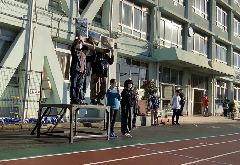
福祉ボランティア委員さん
It has been two weeks since Winter Vacation ended. I had something to look forward to during the Vacation and could enjoy it this time. That something was watching the ekiden. In short, it is a relay marathon. In the famous Hakone Ekiden, five runners run over 100 km from Otemachi in Tokyo to Hakone in Kanagawa, competing by running back and forth.
However, I'm not very good at running long distances. So, I looked up some tips for running long distances.
1 Stretch your back and run. It is good to be aware of keeping your back straight when running.
2 Swing your arms rhythmically. It is also important not to swing them too much.
3 Run at the same pace. It is not good to dash at first and get tired at the end or to run too slowly.
4 Finally, doing exercises such as jumping rope is a good practice to reduce fatigue when running long distances.
The long-distance running week, which started last week, will continue this week. Please keep these tips in mind and set your own goals to run.
令和6年1月15日(月曜日) 「お正月について(自主学習)」 3年担任N.K.先生 Monday, January 15th, 2024 "About New Year's Day (and self-study)" by Ms. N.K., a third grade teacher
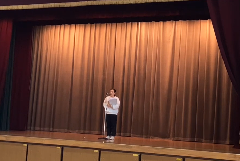
先週から学校がスタートしました。
先週、3の1のお友達の中でお正月の行事についてトッピング学習で調べてきてくれた子がいました。今日は、お正月のことについて紹介したいと思います。
みんなはお正月の行事とか風習、どんなことがあるか知っていますか?
その子はいろいろ調べてきてくれていますが、例えば、正月の料理。おせちとかお雑煮とか七草がゆ。正月飾り。みんなのおうちにも玄関のところに飾ってあったかもしれません。それから、正月遊び。羽根つきや凧揚げ、カルタなんかもあります。正月の行事。みんなももらったと思いますが、お年玉。初夢。書き初めもあったりします。そのお友達は、お年玉や初夢と、初詣に行ったということも書いてありました。みんなが冬休みに取り組んだ書き初めですが、なぜ新年に書き初めをするのか、みんな知っているかなと思って私も調べてみました。二つの意味がありました。一つは、字の上達。字が上手になりますようにと願って新年に書き初めをします。もう一つは、新年の抱負を書いて、今年こんなことをがんばろうとかこんなことにチャレンジしてみようという気持ちを新たにもって取り組むという意味があるそうです。みんなは、書き初めをしたときにそんなことを考えながらしたでしょうか。普段何気なくやっていることでも、「ああ、そういう意味があったんだ。」とか「なるほど、そういうことがあるからこれをするんだ。」っていうことがわかると、その取り組み方が変わってきたり、その思いが変わってくることがあるかなと思います。ぜひ皆さんも自主学習に取り組むことがあると思います。そんなときは、普段何気なくやっていることでも、ちょっと調べてみようかなというふうに思ったことがあれば、自分から進んで調べて、「なるほど。こういう理由があるからやっているんだ。」とか「こういうことをやってみたいな。」というふうにつなげてもらえばいいと思います。もし自分で何か調べてこういうことがわかったというのやこういうことをやってみたいというのがあったら、私のところに見せにきてください。私も一緒に、読んで、頑張ろうねと言う気持ちでいきたいと思います。今日は、お正月についてのお話とトッピング学習についてのお話をしました。気持ちを新たに、今年も頑張りましょう。これでお話を終わります。
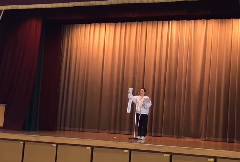
Last week, school started. Last week, one of my students in 3-1 researched New Year's events during self-study. Today, I would like to introduce you to New Year's events. Do you know what kind of New Year's events and customs we have? That student has researched various things:
New Year's cuisine, such as osechi, ozoni, and nanakusa gayu. New Year's decorations. You may have decorated the entrance of your house.
Then, New Year's games. There are feather striking, kite flying, and playing cards.
Next, New Year's events, like Otoshidama(New Year's Monetary Gift). Everyone received some. Also, Hatsuyume(New Year's Dream), and Kakizome(The First Calligraphy).
That student wrote about Otoshidama and Hatsuyume, and they also went to Hatsumode(The First Visit to Temples and Shrines).
It was kakizome that everyone worked on during winter vacation. I also researched why we do kakizome at the beginning of the year. There are two reasons. One is to improve your handwriting. We do kakizome at the beginning of the year, hoping our handwriting will improve. The other is to write a New Year's resolution and work on it with a new feeling of wanting to do our best this year or challenge ourselves with something new. Did you think about such things when you did kakizome? Even things we do casually every day, we can understand that "Oh, there was such a meaning." or "I see, I do this because there is such a thing." The way we approach it may change, and our thoughts may change. Everyone has something to work on in self-study. When you want to look up something that you usually do casually, try to look it up yourself and connect it by saying, "Oh, I see. I'm doing this because of this reason." or "I want to try this." If you have found something by yourself or want to try something like this, please come and show me. I also want to read it together and encourage you.
Today, I talked about New Year's events and Self-studying. Let's do our best this year with a new feeling. That's all. Thank you for listening.
令和6年 1月9日(火曜日) 「新年を迎えて」 川中子校長 Tuesday, January 9th, 2024 "For the New Year" by Principal Kawanago
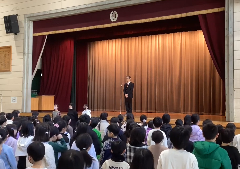
新年最初のあいさつ
みなさん、令和6年、辰年の幕開けです。明けましておめでとうございます。今年もどうぞよろしくお願いします。
お正月を迎えると、みんなが元気に、新しい年を迎えられて「良かったね。」という意味で、お互いに「明けましておめでとう」とご挨拶しますね。しかしながら、今年の元日1月1日に、皆さんもご存じの通り、石川県能登半島で大震災が起きてしまいました。ですから、今、日本の人たちは、心から「新年明けましておめでとうございます」と言えない状態です。大きな地震で、家が潰れてしまったり、津波が来たり、崖崩れなどが起こったりして、たくさんの方が犠牲になりました。石川県だけでなく、日本海側の多くの地方で被害があり、日常の生活が全くできなくなってしまっています。2日には、被災地に支援物資を運ぶことになっていた飛行機が事故を起こし、支援活動に当たっていた海上保安庁の方が命を落としました。この大地震で亡くなられた皆様のご冥福をお祈りし、被災地の皆様にお見舞い申し上げるとともに、一日も早い復興をお祈りしましょう。
さて、そのような年明けとなってしまいましたが、今年はコロナウイルス感染防止の制限が解除されて、初めてのお正月を迎えました。皆さん、家族や親戚の皆さんと楽しい時を過ごすことができたことでしょう。新しい年を迎え、この1年で頑張りたいこと、1年の抱負を考えた人もいますね。私は、今年は体を大切にしたいと思います。昨年末に、先生方と一緒にバドミントンをしました。動くことは動けて、自分ではそんなに年を取ったとは思っていなかったのですが、やってみたらすぐに息が切れてしまい、苦しくなってしまいました。これは持久力が落ちているということです。おなかもお肉がポヨポヨしてきてしまっています。そこで、今まで続けていたラジオ体操につけ加えて、腹筋を習慣化しようと思い、お正月から頑張っています。皆さんは、この辰年の一年をどんな年にしたいですか?
それでは、今日から令和5年度の後期後半がスタートします。この3ヶ月は、1年間の総まとめの時期になります。特に、6年生は6年間通った小学校を卒業し、中学生になるための準備をするときです。私は、みんなが元気に、主体的に生きることができるようになってほしいと願います。そして、去年の自分を超えて、新しい自分に成長していきましょう。
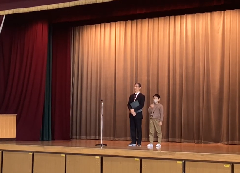
転入生紹介
Happy New Year, everyone! It's the beginning of 2024, the year of the dragon. When we welcome the new year, we greet each other with 'Akemashite omedeto,' which means 'Congratulations on the New Year' and 'I'm glad you made it through the year.' However, as you all know, a major earthquake occurred on January 1st around the Noto Peninsula of Ishikawa Prefecture. Therefore, people in Japan cannot say 'Akemashite omedeto' from the bottom of their hearts. Many people have been affected by the earthquake, with houses being destroyed, tsunamis coming, landslides occurring, and many people losing their lives. In Ishikawa Prefecture, and many other areas along the Sea of Japan, people's daily lives have been completely disrupted. On the 2nd, a plane that was supposed to transport relief supplies to the disaster area crashed, and members of the Japan Coast Guard who were involved in relief activities lost their lives. Let us pray for the repose of the souls of those who lost their lives in this major earthquake, express our condolences to those affected by the disaster, and pray for a speedy recovery.
Despite such a start to the year, we celebrated our first New Year's Day by lifting restrictions on coronavirus infection prevention. You must have had a good time with your family and relatives. Some of you may have thought about what you want to accomplish this year: your New Year's resolutions. As for me, I want to take care of my body this year. At the end of last year, I played badminton with the teachers. I didn't think I was that old, but when I tried it, I ran out of breath right away, and it was painful. It means that my endurance has decreased. My abdomen is also getting a little chubby. So, in addition to the radio exercise I've been doing every morning, I've been trying to make sit-ups a habit since New Year's Day. What kind of year do you want to make this year of the dragon?
Well then, the second half of the second semester of the school year 2023-24 starts today. This three-month period is a time for summarizing the whole year. In particular, sixth graders should prepare to graduate from the elementary school they have attended for six years and become junior high school students. I hope that everyone will be able to live proactively and energetically and that they will grow into new selves beyond their selves from last year.
令和5年12月 December, 2023
令和5年12月18日(月曜日) 「冬至」 2年3組担任O.K.先生 Monday, December 18th, 2023 "The Winter Solstice" by Ms. O. K.
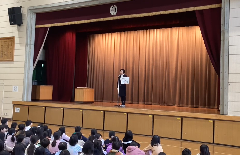
O先生
2年3組担任のO.K.です。今日は皆さんにお話を準備してきました。しっかり聞いてくれると嬉しいです。
はじめに、クイズです。たべもので「○○ん」「○○○ん」というものは、どんなものを思い浮かべますか。(「みかん!」などの声)ありがとう。調べてみると、こんなにたくさんの食べ物があります。「だいこん」「れんこん」「うどん」「きんかん」「かんてん」「ぎんなん」「みかん」
さて、今日は、このような食べ物と関連するお話です。今週の金曜日、12月22日に着いてのお話です。1年間を24の季節に分けた中で、「冬至」という日です。聞いたことありますか。冬至は、1年で最も昼の時間が短くなる日です。今、夕方暗くなるのがとても早くなっています。また、朝明るくなるのも遅くなっています。1年で一番昼の時間が短い日を冬至と呼んでいるのです。世界でもこの冬至の日のことはいろいろと考えられて入て、「太陽が生まれ変わる日」とか「新年の始まり」とか「季節の折り返し地点」と考えられているそうです。つまり、冬至の次の日から、昼の時間が少しずつ長くなりますので、ちょうど一年の変わり目と思われているそうです。
皆さんの住んでいる日本でも、冬至の日に行われる風習があります。一つ目。「ゆず湯」に入る。なぜ、ゆず湯に入るのかというと、肌荒れを防いだり、風邪を引かなくなったり、体を温めたりする効果があります。また、先程紹介した「ん」がつく食べ物を食べます。これは、「運が良くなる」と考えられています。そして、中でも、カボチャを食べることがよく行われています。カボチャには「ん」がついてないのですが、実はカボチャの別名は「なんきん」といって、二つも「ん」がついています。「運が良くなる」ということです。
今週の金曜日、小林先生が考えてくださっている給食メニューでもカボチャが登場します。あとでメニューを確かめてみてください。
今日は冬至についてお話ししました。お話をしっかり聞いてくれて嬉しいです。これで終わります。
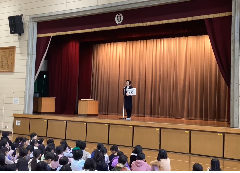
冬至には
Hello, everyone. I'm O. K., the homeroom teacher of 2-3. Today, I've prepared a story for all of you. I'd be delighted if you listened attentively.
Let's start with a quiz. When you hear the sound "○○ん" (like in "みかん" - mikan) or "○○○ん," what kind of food comes to mind? (Responses: "Oranges!" and others.) Thank you. I found that there are many foods with this sound; "daikon," "renkon," "udon," "kinkan," "kanten," "gin'nan," and "mikan."
Now, I will talk about a story related to these foods. It's about a specific day that arrives this Friday, December 22nd. This day is known as the Winter Solstice within the year's division into 24 seasons. Have you heard of it? The Winter Solstice marks the shortest day and longest night of the year. Evenings are growing darker much earlier, and mornings are slower to brighten. It's the day when daylight hours are at their minimum. Across the world, people have various interpretations of the Winter Solstice; some consider it the "rebirth of the sun," the "beginning of a new year," or the "midpoint of the season." It's a turning point, as the days gradually lengthen from the day after the Winter Solstice.
Even in Japan, where you reside, customs are associated with the Winter Solstice. Let me share a couple of them:
Yuzu-yu (Citrus Bath): People take baths with yuzu (a type of citrus fruit). Why? Yuzu is believed to prevent skin issues, ward off colds, and warm the body.
On this day, people also eat foods that end with the sound "ん" (like "mikan"). It's thought to bring good luck. Among these foods, pumpkin (kabocha) is commonly eaten. Interestingly, while pumpkin doesn't end with "ん," its alternate name is "nankin," which indeed has two "ん" sounds. So, it's associated with good fortune.
This Friday, our school lunch menu will feature pumpkin. Be sure to check it out later.
Today, I talked about the Winter Solstice. Thank you for listening attentively.
令和5年12月11日(月曜日) 「書き初め」 1年担任・T.M.先生 Monday, December 11th, 2023 "Kakizome," by Ms. T.M., a first-grade teacher
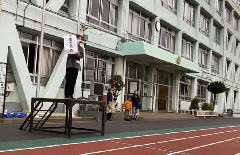
「書き初め」
12月も第2週目に入りました。もうそろそろ、書き初めの練習が始まるのではないでしょうか。
書き初めというのは、日本ではお正月の行事として古くから行われています。平安時代、貴族の人たちの中で始まって、1年の最初に、新しい年になったお祝いの詩を書いたりしたところから始まったそうです。その後ずっと続いてきて、江戸時代に寺子屋では、子供たちも書くようになり、それから明治時代になって学校が始まり、学校の中でも書き初めは行われるようになりました。
書き初めをすると、字が上手になるとか願いが叶うといわれます。今年1年どんな年にしようかなと、「抱負」といって、めあてとか目標みたいな、「こうなりたいな」というというのを書くようになったそうです。
そして昔から日本の人は、言葉には力がある。「言霊」という言葉は聞いたことあるかな?言葉には力があるというのを信じていた。だから、こうなりたいとかこういうことをするぞと、思ったことを、きちんと言葉で言ったり、目標を書いたりするというのを1年の最初にやっていたということですね。
今でも、例えば、スポーツ選手が「○○大会優勝!」というのを目標として貼ったり、「優勝です」「金メダルを取ります」と、自分で言葉にして表しているんですね。そういうことって、言霊という願いが叶うというだけでなく、努力することにもつながるんです。自分で言葉にしてやっていけたら素敵だなって思います。これから書き初めの練習だけでなく、毎日の生活の中で、つい「そんなのできないよ。」って言ってしまうこともあるかもしれないけれど、そうじゃなくて、自分だったら「今度はこの字を上手に書こう」とか、他の活動でも、この次はこんな風になりたいな、あるいは、こういう風にするぞというめあてを書いて頑張ってほしいなと思います。
これでお話を終わります。

「言霊」
We are now in the second week of December. It's about time to start practicing kakizome, or the first calligraphy of the year. Kakizome is a traditional Japanese New Year's event practiced since ancient times. It began in the Heian period when the nobles wrote poems to celebrate the new year, and it continued throughout the ages. In the Edo period, children in temple schools also started to write kakizome. Then, in the Meiji era, when schools were established, kakizome became a part of school activities. It is said that writing kakizome will make your handwriting better or grant your wishes. People would write their hopes and goals for the new year; we call it "aspirations." Since ancient times, Japanese people believed that words have power. Have you ever heard of the word "kotodama"? It means the spirit of words. Our ancestors believed that, by expressing their thoughts in words, either by speaking or writing, they could make their wishes come true at the beginning of the year. Even today, for example, athletes post their goals like "Win the XX tournament!" or say "I will win" or "I will get the gold medal." They are using words to declare their intentions. It is not only about Kotodama, or making wishes come true but also about motivating themselves to work hard. Please do the same with your words. Not only for kakizome practice but also for your daily life, you may sometimes say, "I can't do that" or "I'm not good at that," but instead of that, I hope you can set your own goals like "I will write this character better next time" or "I want to be like this in the next activity" or "I will do this." Please work hard with your goals in mind. That's all for today. Thank you for listening.
令和5年12月4日(月曜日) 「誰もが安心していられるクラス、学校」 川中子校長
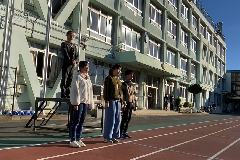
6年生代表のあいさつ
おはようございます。12月になり、随分寒くなってきました。昨日の朝、外に出ると車の窓が白く凍っていました。歩いていると、足下の草が真っ白に霜が降りています。よく見たら、霜柱が立っているところもありました。冬になったのですね。私も、先週末からちょっと風邪気味ですが、皆さんもくれぐれも気をつけてください。
さて、先週、6年生の人たちが作文を書いたので読んでくださいと届けに来てくれました。早速読ませてもらいましたが、学校生活で困っていることなどについて、校長先生に考えてほしい、という意見が書かれていました。例えば、クラスで使っているボールが、すぐ空気が抜けてしまうので、もっといいものに替えてほしいとか、コロナ前まであった朝の遊び時間を復活させてほしいという意見が多くありました。よく書けていて、私を納得させてくれる作文もたくさんありました。実現できそうなことは、先生たちで考えてみます。
その作文の中に、とても深刻なものがありました。それは、クラスの中で暴力・暴言・いじりなどがあり、つらい思いをしている人がいるので、いじめをなくしたいというものでした。同じ内容のことを二人の人が書いてくれていました。皆さんのクラスはどうですか?
私は、今、本気で私たちの学校から、つらい思いをしている人やいやな思いをしている人をなくしたいと思っています。私たちの教育目標の通り、「思いやりをもち、共に生きる人」になってほしい。そのためにも、今、皆さんは「自ら学び、考え、行動する人」にならなければなりません。それは「勇気を出して、正しい行動をする人」という意味ですね。
3年生以上の人たちは、前に、大阪の大空小学校の映画を見たのを覚えていますか。あの学校では、もちろん、けんかしたりすることはありますが、いじめのようなことはほとんどないそうです。私たちの学校にも、そういうクラスがあります。みんなが安心していられるクラスっていうのは、作れるんですよ。先生たちも、そんなクラス、そんな学校になるように今みんなで勉強しています。みんなで、三吾小を誰もが安心していられる学校にしていきましょう。
今日は、東京都の教育委員会から、皆さんに伝えてほしいというお話も続けてします。よく聞いてください。
みなさんの体や心は、自分だけのもので、一番大切なものです。また、友だちの体も自分の体と同じように大切なんだということも知ってください。
誰かを叩いたり、蹴ったりして、痛い思いや怪我をさせることを暴力といいます。悪口や相手が嫌がるようなことを言って、相手の心を傷つけることも、言葉の暴力になります。人を叩いたり、嫌な事を言ったりして、誰かの身体や心を傷つけたりすることは、友達同士でやってはいけないことであり、親や先生も、どんな大人の人も決してやってはいけないことです。
他にも、一学期に、お話ししたように、体の大事な部分に触ろうとしたり、服で隠れている部分をのぞこうとすること、メールとかラインで、体の大事なところを見たいなと言ってくることも、おかしいな、モヤモヤするな、イヤだな、気持ち悪いなと感じることですので、これも、友達同士でやってはいけないし、大人の人も決してやってはいけないことです。もし、誰かが近づいてきて、みなさんが、そんな嫌なことをされそうになったときは、どうしたらよいでしょうか。そんなときは、はっきりと「いやだ」と言って、逃げてください。メールとかラインだったら、その人とのやり取りは、止めてください。みなさんに、暴力やおかしいな、気持ち悪いなと思うようなことをしてはいけないのは、先生たちも同じです。先生たちは、学校の中でも、学校の外でも、みなさんに嫌なことをしてはいけないルールを守ります。もしも、ルールを守らない先生がいたら、みなさんは「いやです」と言ってよいのです。
もし、誰か大人の人に、嫌なことをされたときは、おうちの人や、ほかの先生など、安心して話せる大人に教えてください。自分がされた場合だけでなく、友だちがされているのを見た場合も同じです。でも、知っている人には話しにくいな、誰に話したらよいのだろうと迷うことがあるかもしれません。誰にもお話できないと思っている人のために、お話を聞いてくれるところがあります。相談先については、あとで皆さんにロイロノートで送ります。メールや電話で相談することもできますから覚えておいてください。
校長先生も先生たちも、みなさんのことを大事に思っています。ぜひ一人で悩まないで、いつでもお話してください。
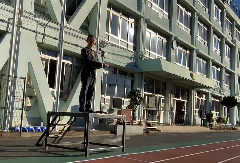
都教委からのお便りも
Good morning. It's December, and it's getting quite cold. When I went outside yesterday morning, the car windows were frozen white. As I walked, I saw the grass covered with white frost. When I looked closely, I saw some frost pillars standing. It's winter. I've had a slight cold since last weekend, so please be careful, everyone.
Last week, the sixth graders came to me with their essays and asked me to read them. I read them right away, and they wrote about things they were having trouble with in school life and asked me to think about them as the principal. For example, many said they wanted to replace the balls they use in class with better ones because they lose air quickly. Many wanted to bring back the morning playtime they had before corona. They wrote well, and many essays convinced me. I'll think about what we can do with the teachers.
Among the essays, there was one that was very serious. It was about how there is violence, verbal abuse, teasing, etc., in the class and how some people are suffering and want to get rid of bullying. Two people wrote about the same thing. How is your class?
I am considering how to eliminate people's suffering or feeling bad from our school. I want you to become "people who live together with empathy," as our educational goal says. You must become "people who learn, think, and act independently" now. That means "people who have the courage to do the right thing."
Do you remember the movie we watched before about Ozora Elementary School in Osaka for those of you who are in third grade or higher? Of course, there are fights and such at that school, but hardly any bullying exists. We have classes like that in our school, too. A class where everyone can feel safe is possible to create. The teachers are also studying together to make such a class, such a school. Let's all make San-Azu Elementary School a school where everyone can feel safe.
Today, I have another message from the Tokyo Metropolitan Board of Education that I want to share with you. Please listen carefully.
Your body and mind are your own and the most important things. Also, please know that your friends' bodies are as important as yours. We call it 'violence' to hit or kick someone and cause them pain or injury. It is also verbal violence to say bad things or things that the other person doesn't like and hurt their feelings. Hitting or saying nasty things to someone and hurting their body or mind is something that you should not do to your friends, and neither should your parents, teachers, or any other adult. There are also things I talked about in the first semester, such as trying to touch the private parts of your body, peeking at the parts hidden by your clothes, or sending messages or Lines saying that you want to see the private parts of other's body. These things make you feel weird, uneasy, or uncomfortable, so you should not do them to your friends, and no adults should, either. What should you do if someone comes close to you and tries to do something unpleasant to you? In that case, say "no" clearly and run away. Stop communicating with that person, whether by email or Line. The teachers also have to follow the rule that they should not do anything unpleasant to you inside or outside the school. If a teacher does not follow the rule, you can say "no." If someone does something unpleasant to you, please tell an adult you can trust, such as your family or another teacher. This is the same not only when it happens to you but also when you see it happening to your friends. But you may be wondering who to talk to or feel uncomfortable talking to someone you know. There is a place where you can speak to someone who will listen to you for those who think they can't talk to anyone. I will send you the contact information later by Loilo-Note. Remember, you can also get help by email or phone, too. The teachers, as well as I, care about you. Please don't hesitate to talk to us anytime.
令和5年11月 November, 2023
令和5年11月27日(月曜日)「百人一首」音楽専科・Y先生 Monday, November 27th, 2023 "Hyakunin Isshu (One Hundred Poems of One Hundred Poets)"
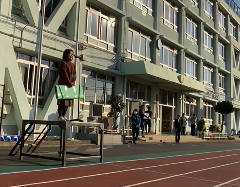
音楽専科Y先生
皆さん、おはようございます。音楽のYです。
今週はもう12月に入りますね。私は毎年、小学生の頃から、この時期になると「そろそろ、練習を始めなきゃ!」と思うものがあります。それは百人一首です。私が小学校4年生の時に、クラスで百人一首をやっていました。その時、自分の家の近くに住んでいる女の子の友達に負けてしまったことが、とっても悔しくて、4年生の冬休みに百韻一首を全部覚えてました! 今日はその中から皆さんに一つ紹介したいと思います。
じゃじゃん! 読んでみましょう。「よしののさとにふれるしらゆき」これは、カルタの取り札です。この取り札の上の句がわかる人いますか?
百人一首は、百人の人が書いた素晴らしい和歌を集めたものです。百人一首のカルタの遊びでは、上の句が読まれて、下の句が取り札としておいてあります。上の句を覚えている人は、上の句が読まれたときに、すぐに下の句を取ることができますよね。この歌の上の句は「朝ぼらけ 有明の月と 見るまでに」です。その後に、下の句「吉野の里に 降れる白雪」と続きます。この歌の意味は、「朝ぼらけ」というのは、朝の夜明けの頃のことです。まだ暗い暗い、夜明けの時に、「あれ?まだ暗いはずの夜明けの時なのに、何だか外が明るいな。」というのが上の句の意味です。「もしかしたら、朝のぼんやりした月の明かりなのかな?」と思って外を見てみると、これは吉野の里というところに雪が積もっていて、雪のせいで外が明るかったのだという意味です。平安時代の時の歌なので、その時はまだ、スイッチを押せば電気がつくということもなかったので、そういうほんのりとした明かりに心が動かされたということを詠んだ歌で、とても素敵だなと思います。
皆さんも百人一首に興味があったら、ぜひやってみてください。私と戦いたい人は、ぜひ音楽室まで来てください。これでお話を終わります。
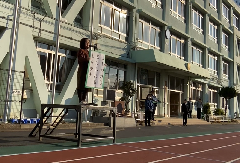
大きな取り札
I'm Y, the music teacher. This week, we will enter December. Every year since I was in elementary school, I have something that makes me think, "I have to start practicing soon!" around this time of year. That is Hyakunin Isshu. When I was in fourth grade, we did Hyakunin Isshu in class. At that time, I lost a friend who lived near my house, and I was so frustrated that I memorized all 100 poems during the winter vacation of that year! Today, I would like to introduce one of them to you.
Ta-da! Let's read it.
"Yoshino no sato ni fureru shirayuki"
This is the card to take in the card game. Does anyone know the first half of this poem? Hyakunin Isshu is a collection of wonderful waka poems written by 100 people. In the card game of Hyakunin Isshu, the first half is read, and the second half is placed as a card to take. If you remember the first half, you can take the second half as soon as the first half is read. The first half of this poem is "Asaborake ariake no tsuki to miru made ni." Then, the second half follows, "Yoshino no sato ni fureru shirayuki." The meaning of this poem is... "Asaborake" means the time of dawn. It is still dark at dawn, and the meaning of the first half is, "Huh? It should still be dark at dawn, but somehow it is bright outside." The writer thought, "Maybe it's the light of the moon in the morning?" When he looked outside, it was snowing in a place called 'Yoshino no sato,' and the snow made it bright out. It is a poem from the Heian period, so there was no such thing as turning on the electricity by pressing a switch. It is a poem that expresses the feeling of being moved by such a faint light, and it is gorgeous. If you are interested in Hyakunin Isshu, please try it. Please come to the music room if you want to play with me. That's all. Thank you for listening.
令和5年11月20日(月曜日) 「水墨画」 4年担任M.K.先生 Monday, November 20th, 2023 "Suiboku-ga" by Ms. M. K., a fourth grade teacher
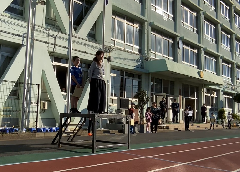
M先生と4年生
皆さんは、絵を描くとき、どんな絵を想像しますか? いろいろな色がついた絵を想像するのではないかなと思います。ですが、墨と水を使って、墨を水で薄めながら、黒一色で描く水墨画というのがあるのを知っていますか。今日は水墨画についてお話しします。
水墨画は鎌倉時代に中国から伝わってきました。今から700年〜800年前に伝わってきました。墨を水で薄めながら、うすくしたり、ぼかしたりしながら絵を描いていきます。日本では、鉄舟という人が描いた水墨画がとても有名で、その作品の中の六つが国宝とされています。実は、4年生がその水墨画を、7月に体験してみました。実際に体験してみた感想を4年生に聞いてもみたいと思います。
Aさん:水墨画を初めてやってみて難しかったところは、墨を水で薄めるときに水が多すぎてびちょびちょにならないようにすることです。水墨画の特徴は色が薄いところです。いつもの習字の時は色が濃いけれど、水を加えることで色が薄まります。
Bさん:初めて水墨画をやってみて難しかったですが、いつもの鉛筆やクレヨンで描くときよりうまく描けた気がしました。楽しかったです。
有り難うございました。このように、黒い墨を薄めながら、薄くしたり、濃くしたりしながら描く水墨画は、白と黒しかないので、見ている人がどんな色なのかな、どんな様子なのかなと想像しながら見る良さがあって、とても素敵ですよね。皆さんも、今週水曜日から展覧会が始まります。どんな作品がそろっているのか、皆さんも楽しみにしているところだと思います。ぜひ、友達や他の学年の人の作品の良いところをたくさん見つけてほしいなと思います。これでお話を終わります。
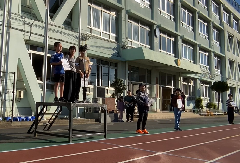
4年生児童
What kind of picture do you imagine when you draw a picture? You might imagine a picture with various colors. But do you know there is a type of painting called 'suiboku-ga,' which is drawn with ink and water, using only black color while diluting the ink with water? Today, I will talk about suiboku-ga. Suiboku-ga was introduced from China in the Kamakura period, about 700 to 800 years ago. You draw a picture by diluting the ink with water, making it thinner or blurred. In Japan, the suiboku-ga drawn by a painter, Tesshu, is very famous, and six of his works are designated national treasures. The fourth graders tried suiboku-ga in July. Let's hear some impressions of the fourth graders who tried it.
A: The difficult part of doing suiboku-ga for the first time was preventing the water from being too much and making it soggy when diluting the ink with water. The main feature of suiboku-ga is that its color is light. The color is dark when I do calligraphy as usual, but the color becomes lighter by adding water.
B: It was challenging to do suiboku-ga for the first time, but I felt I could draw better than when I drew with pencils or crayons. It was fun.
Thank you very much. As you can see, suiboku-ga, which is drawn by diluting black ink, making it thinner or darker, has the charm of making the viewer imagine what color it is and what kind of situation it is because it only has white and black. I think you are all looking forward to seeing what kind of works are collected at the Exhibition that starts this Wednesday. I hope you will find a lot of good points in the works of your friends and other grade students.
That's all. Thank you for listening.
令和5年11月13日(月曜日) 「七五三」 6年担任E先生 Monday, November 13th, 2023 "About Shichi-go-san" by Ms. E. S., a sixth-grade teacher
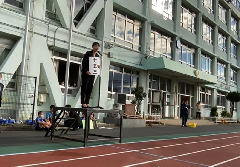
E先生
おはようございます。6年2組担任のEです。
それでは、皆さんに問題です。今週の水曜日、11月15日は何の日でしょうか。(「七五三!」)そうです。11月15日水曜日は七五三の日です。やったことがある人もいると思います。これからやるよ、っていう人もいるかもしれません。
七五三って、どうしてやるか知っていますか? 昔は、健康に大きく育つのが、なかなか難しかったそうです。「七つ前は神の道」と言われていて、7歳まで生きるのがとても難しかったと言われています。今、皆さんは、すくすく元気に成長していますね。6年生はもう、12歳になった人もいるのかな? 神様に、健康で大きくなった自分の姿を見せるというのが、七五三の意味だそうです。
日本には、こういった伝統や文化という、すごく古くから受け継がれているものがたくさんあります。ぜひ、日常の中から、生活の中からそういうものを見つけられるといいですね。
今日は七五三のお話をしました。これでお話を終わります。
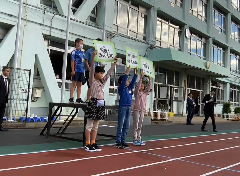
代表委員
Good morning. I am E., the homeroom teacher of class 6-2. Here is a question for you. What day is this Wednesday, November 15th? (Students said, "Shichi-go-san!") That's right. Wednesday, November 15th, is Shichi-go-san(Literally meaning, 'seven-five-three').
Some of you may have experienced it before. Some of you may be going to experience it soon.
Do you know why we celebrate Shichi-go-san?
Long ago, it wasn't easy to grow up healthy. It was said that "Before seven, one is a god's child," meaning it was very hard to survive until seven. Now, you are all growing up strong and healthy. Some of the sixth graders may have already turned 12, right? Showing the gods your healthy and grown-up self is the meaning of Shichi-go-san.
Japan has many traditions and cultures passed down from ancient times. I hope you find such things in your daily life and activities. Today, I talked about Shichi-go-san. That's all. Thank you for listening.
令和5年11月6日(月曜日) 「もう二度と戦はしない」 川中子校長
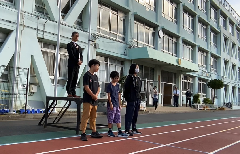
6年生代表
11月になりました。11月は昔の言い方で「霜月」と言います。寒くなって、霜が降りるようになる月という意味ですが、今年はまだまだ暖かい日が続いていますね。
さて、先週の金曜日11月3日は祝日でしたが、何の日か知っていますか。「文化の日」と言います。「自由と平和を愛し、文化をすすめる」ための祝日です。1948年、昭和23年に制定されました。
なぜこの日が祝日になったのか、その理由は二つあります。戦争が終わった次の年、1946年11月3日に、新しい、日本の憲法が公布されました。その事を記念してこの日が「文化の日」となりましたが、もともとこの日は明治天皇の誕生日だったことも関係しているそうです。
「憲法」というのは、国の大切な決まりのことです。私たち一人一人には守らなければならない「法律」という決まりがあります。憲法は、その法律を考える立場の人たちが守らなければならない決まりです。決まりを成り立たせるための決まりです。
戦後新たに作られた日本の新しい憲法は、1947年5月3日から施行されました。それで、5月3日が「憲法記念日」の祝日になっています。この「日本国憲法」は、明治の世から始まり、昭和20年8月15日の終戦まで進められた戦争への深い反省から生まれたもので、私たちは今後、国際的な問題を解決するために、決して武力を使わない、二度と戦争は起こさない、と世界に対して誓ったものです。その決意が、憲法の前文や条文の中に書かれています。今日は、そのうち、第2章「戦争の放棄」の部分を、劇作家の井上ひさしという方が皆さんにもわかる言葉で書き直したもので紹介します。
(「井上ひさしの 子どもに伝える日本国憲法」より 日本国憲法第9条
「もう二度と戦はしない」)
皆さんの生きている今も、世界では戦争や紛争がたえません。長引くロシアとウクライナの戦争で世界中の人たちが胸を痛めている最中に、中東のイスラエルではアラブ人とユダヤ人の間で紛争が悪化し、お互いに攻撃し合い、この一月の間にすでに1万人以上の方が亡くなられています。
どうしたら、世界中の人々は、勇気を奮い起こして、戦争をやめることができるようになるでしょう。さっき紹介した憲法の条文に書かれていた通り、「どんなもめごとも筋道をたどってよく考えて、ことばの力をつくせば、かならずしずまる。よくかんがえぬかれたことばこそ、私たちのほんとうの力なのだ。」と私は信じたい。皆さんは、今、学校でいろいろなことを学んでいますが、それは、皆さんがこの難しい問題に答えを見つけ出すためなのです。私たちの学校教育目標も日本国憲法が目指すものと同じです。これから先も、皆さんが決して戦争を体験しないことを、そして世界中の人たちが戦争をやめて話し合いができるようになることを、心から祈っています。
11月になりました。11月は昔の言い方で「霜月」と言います。寒くなって、霜が降りるようになる月という意味ですが、今年はまだまだ暖かい日が続いていますね。
さて、先週の金曜日11月3日は祝日でしたが、何の日か知っていますか。「文化の日」と言います。「自由と平和を愛し、文化をすすめる」ための祝日です。1948年、昭和23年に制定されました。
なぜこの日が祝日になったのか、その理由は二つあります。戦争が終わった次の年、1946年11月3日に、新しい、日本の憲法が公布されました。その事を記念してこの日が「文化の日」となりましたが、もともとこの日は明治天皇の誕生日だったことも関係しているそうです。
「憲法」というのは、国の大切な決まりのことです。私たち一人一人には守らなければならない「法律」という決まりがあります。憲法は、その法律を考える立場の人たちが守らなければならない決まりです。決まりを成り立たせるための決まりです。
戦後新たに作られた日本の新しい憲法は、1947年5月3日から施行されました。それで、5月3日が「憲法記念日」の祝日になっています。この「日本国憲法」は、明治の世から始まり、昭和20年8月15日の終戦まで進められた戦争への深い反省から生まれたもので、私たちは今後、国際的な問題を解決するために、決して武力を使わない、二度と戦争は起こさない、と世界に対して誓ったものです。その決意が、憲法の前文や条文の中に書かれています。今日は、そのうち、第2章「戦争の放棄」の部分を、劇作家の井上ひさしという方が皆さんにもわかる言葉で書き直したもので紹介します。
(「井上ひさしの 子どもに伝える日本国憲法」より 日本国憲法第9条
「もう二度と戦はしない」)
皆さんの生きている今も、世界では戦争や紛争がたえません。長引くロシアとウクライナの戦争で世界中の人たちが胸を痛めている最中に、中東のイスラエルではアラブ人とユダヤ人の間で紛争が悪化し、お互いに攻撃し合い、この一月の間にすでに1万人以上の方が亡くなられています。
どうしたら、世界中の人々は、勇気を奮い起こして、戦争をやめることができるようになるでしょう。さっき紹介した憲法の条文に書かれていた通り、「どんなもめごとも筋道をたどってよく考えて、ことばの力をつくせば、かならずしずまる。よくかんがえぬかれたことばこそ、私たちのほんとうの力なのだ。」と私は信じたい。皆さんは、今、学校でいろいろなことを学んでいますが、それは、皆さんがこの難しい問題に答えを見つけ出すためなのです。私たちの学校教育目標も日本国憲法が目指すものと同じです。これから先も、皆さんが決して戦争を体験しないことを、そして世界中の人たちが戦争をやめて話し合いができるようになることを、心から祈っています。
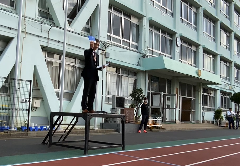
井上ひさし「子どもにつたえる日本国憲法」
It is November. November is called "Shimotsuki (frost month)" in the old Japanese calendar. It means the month when it gets cold and frost appears, but, this year, we still have many warm days.
Well, last Friday, November 3rd, was a national holiday, but do you know what day it was? It is called "Culture Day". It is a holiday to "love freedom and peace and promote culture." It was established in 1948.
Why did this day become a holiday? There are two reasons. The year after the war ended, on November 3rd, 1946, a new constitution of Japan was promulgated. This day became "Culture Day" to commemorate that. Still, it also had something to do with the fact that it was originally the birthday of the Meiji Emperor.
The constitution is the most important rule of the country. Each of us has a rule called "law" that we must obey. The constitution is the rule that the people who make the laws must obey. It is the rule to make the rules work.
The new constitution of Japan, which was created after the war, came into effect on May 3rd, 1947. That is why May 3rd is a national holiday called "Constitution Memorial Day". This "Constitution of Japan" was born from a profound reflection on the war that started in the Meiji era and lasted until August 15th, 1945. We swore to the world that we would never use force to solve international problems and that we would never start a war again. That determination is written in the preamble and an article of the constitution. Today, I will introduce one of them, the part in Chapter 2, "Renunciation of War", which was rewritten by a playwright named Inoue Hisashi in words you can understand.
(Reading the book, "Inoue Hisashi's Constitution of Japan for Children" from Article 9 of the Constitution of Japan: "We will never fight again.”)
Even now, when you are alive, there are wars and conflicts all over the world. In the midst of the world's people's anguish over the prolonged war between Russia and Ukraine, the conflict between Arabs and Jews in Israel, which is in the Middle East, has worsened. They have attacked each other, and more than 10,000 innocent people have already died.
How can people around the world muster the courage to stop fighting? As it was written in the constitution article I introduced earlier, "If we think carefully and follow logic, we'll be able to solve any problem. The words we think well are our true power," I want to believe this. You are learning various things at school now, and that is for you to find the answer to this difficult problem. Our school's educational goals are the same as what the Constitution of Japan aims for. I sincerely hope that you will never experience war in the future and that people around the world will stop fighting and be able to talk to each other.
令和5年10月 October 2023
令和5年10月31日(火曜日) 「三吾スポーツフェスティバルを振り返って」 川中子校長 Tuesday, October 31st, 2023 "An Evolving School - The Students Are The Protagonists" by Principal Kawanago
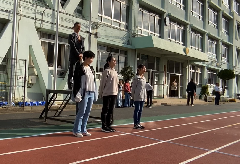
6年生代表あいさつ
先週末は、進化する三吾小の新しい運動会「三吾スポーツフェスティバル」でしたね。
私は、4年ぶりに全校児童が一緒に集まって開催ができたことと、皆さんが生き生きと競技や演技に参加して、とても楽しそうだったのがとても印象に残りました。
今年、三吾小は、皆さんがどうしたらもっと主体的になれるかと、いろいろ考えています。そして、学校を、もっともっと子供たちのもの、皆さんのものにしようと思っています。運動会のやり方もそのように考えて、変えてみました。今年の三吾スポーツフェスティバルは、皆さんにとってはいかがでしたか?
まず、今の4年より下の人たちにとっては、今年は初めて、全校児童が一緒に運動会を行うことができたわけですが、他の学年の競技や演技を見て、どうでしたか? 上の学年の人たちは、かっこよかったですよね。下の学年の人たちは、一生懸命やっていて素敵でしたよね。
6年生は、準備から片づけまで、いろいろな係活動をやってくれて、すごかったですね。6年生は、この運動会へ向けて実行委員会を作って、いろいろ自分たちで考えて準備したり、練習したりしたそうです。特に、全校応援をやってくれた応援団のみなさんは、スポーツフェスティバルを盛り上げるために、自分たちでやり方を考えて、応援をしてくれました。開会式の応援だけでなく、各学年が始まる前に応援団がエールを送ってくれたので、とても励みになりましたね。そして、その6年生の姿を見て、5年生のみんなが思いっきり声を出してくれていました。1年生が入場するときには、歌まで歌ってくれましたね。とても楽しく、幸せな気分にさせてくれましたね。そのほかの皆さんも、他の学年の演技や発表に、たくさん声援を送っていました。
もう一つ、大きく変わったところは、今年は、あまり勝ち負けにこだわらないようにしたことです。一人一人の人は、みんなそれぞれ違うので、走るのが速い人もいれば、速くない人もいます。だから、今年はまず、短距離走を他の人と比べるのではなく、自分自身が練習してどれだけ速く走れるようになるかを目標にしてみました。自己ベストを目指して頑張るというのは、どの人にとっても同じ条件ですね。同じように学年種目も、1組と2組と3組で、どのクラスが一番かと競争する代わりに、自分たちのクラスが練習の時からどれだけ上手にできるようになるかを目指してみました。その結果、例えば、2年生の大玉転がしは、赤白どちらも68秒も記録を更新することができたし、3年生の台風106号では、終わった後、一番速くゴールしたクラスの人たちだけでなく、一番最後にゴールしたクラスの人たちも、記録を更新して「やったー!」と歓声が上がりました。こんなふうに、スポーツの楽しみ方を変えてみたのも、今年のスポーツフェスティバルの特徴でした。
今日、後で、皆さんにアンケートを送ります。スポーツフェスティバルが皆さんにとってはどんなものだったのかを教えてください。
進化し続ける第三吾嬬小。来年は、もっともっと皆さんの運動会にしたいと思っています。6年生は卒業してしまいますが、そのほかの学年の人は、来年はどんなことをやってみたいですか? 今年はまだまだ先生たちがいろいろ決めて取り組んだことが多かったけれど、例えば、やる競技や表現のダンスを自分たちで考えてもいいんですよ。どうですか?やってみたいですか?
学校の主人公は皆さんです。ぜひ「自ら学び、考え、行動する人」になってください。
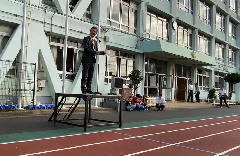
Last weekend, we had a new sports festival, "San-Azu Sports Festival," of the evolving San-Azu Elementary School, right? I was very impressed that all the students gathered together for the first time in four years and that everyone participated in the competitions and performances with great enthusiasm and joy.
This year, we teachers are thinking about how you can become more proactive. And we want to make the school more and more yours, the students'. We also changed how we would have the sports festival with that in mind. How was this year's San-Azu Sports Festival for you?
First of all, for those who are in the fourth grade and younger students, this was the first time that they could do the sports festival with all the students together. How was it to see the competitions and performances of other grades? The upper grades were fantastic, weren't they? The lower grades were terrific too because you saw they did their best. The sixth graders did various duties, from preparation to cleaning up, and they were amazing. The sixth graders formed an executive committee for this sports festival and prepared and practiced various things by themselves. In particular, the cheerleaders, who cheered for the whole school, designed their way of cheering. Not only the opening ceremony cheering, but also the cheers before each grade started, which was very encouraging. And seeing those sixth graders, the fifth graders shouted out loud. When the first graders entered, they even sang a song. They made us feel delighted. The rest of you also gave a lot of cheers to the performances and presentations of other grades.
Another significant change was that this year, we tried not to care too much about winning or losing. Everyone is different, so some people are fast at running, and some are not. So this year, we first tried to aim for how fast we can run by ourselves instead of comparing ourselves with others in the short-distance run. Trying to achieve your best is the same condition for everyone, right? Similarly, in the grade events, instead of competing with other classes to see which class was the best, we aimed to see how well we could do compared to when we practiced. As a result, for example, in the second grade's big ball rolling, both red and white teams were able to update their records by 68 seconds, and in the third grade's Typhoon 106, not only the people in the class who finished first but also those who finished last updated their records and shouted "Hurray! We did it!" It was also a characteristic of this year's sports festival, changing how we enjoy sports.
Today, later, I will send you a questionnaire. Please tell us what the sports festival was like for you.
San-Azu Elementary School continues to evolve. Next year, we want to make it even more your sports festival. Although the sixth graders will graduate, what do you want to do next year for everyone else? This year, there were still many things that teachers decided and worked on. Still, for example, you can think of your competitions or dance expressions. How about it? Do you want to try it? You ARE the protagonists of the school. Please become a person who "learns, thinks, and acts independently."
令和5年10月23日(月曜日) 「○○な秋」 5年担任T.S.先生 Monday, October 23rd, 2023 "Various Autumns" by Mr. T. S., a fifth-grade teacher
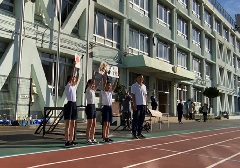
T先生と5年生
おはようございます。5年担任のTです。私の顔を見たことあるよ、っていう人は?
ありがとうございます。
今日、私が話す話のテーマは「秋」です。秋は、実は、9月くらいから。暦の上では8月から秋と言われます。
「秋」と聞いて、みなさんは、どんなことを思い浮かべますか。では、5年生に聞いてみたいと思います。5年生の皆さん!では、みなさんはどんな秋にしたいですか?
Aさん:私は秋刀魚を食べたい!
Bさん:私は絵を描きたい!
Cさん:私は紅葉が見たいな!
いろんな秋の過ごし方があると思います。たとえば、Aさんが言ってくれた「秋刀魚」。これ「秋」という漢字が入っていますね。こういうのを「○○の秋」って言うんですが、知っている人? はい、素晴らしい!そうですね。「食欲の秋」と言います。次にBさん。絵を描きたいと言っていました。「芸術の秋」ですね。そして、Cさんが言っていた「紅葉を見に行きたい。」「紅葉」の秋ですね。このように「○○の秋」というのはいろいろあります。それでは、先生たちにも聞いてみたいと思います。Dさん!
Dさん:H先生はどんな秋にしたいですか?
H先生:私は「スポーツの秋」にしたいと思います。大好きなバスケットボールをやって、健康な体を作りたいなと思っています。
Dさん:ありがとうございました。
はい。「スポーツの秋」も有名ですね。さっき、校長先生も言ってましたが、今週末スポーツフェスティバルがありますね。そして、11月に何があるか知っていますか? 展覧会があります。展覧会は、どの秋かな?そうですね、「芸術の秋」です。
いろんな秋を、頑張って取り組みましょう。これでお話を終わります。
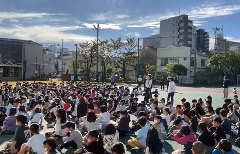
H先生はどうですか?
Good morning. I'm T, a fifth-grade teacher. How many of you have seen my face before? Thank you. Today, the topic of my talk is "autumn".
Autumn starts around September. On the calendar, it is said that autumn starts from August. What comes to your mind when you hear "autumn?" Let's ask the fifth graders. Fifth graders!
T: What kind of autumn do you want to have?
A: I want to eat samma (Pacific saury)!
B: I want to draw pictures!
C: I want to see the autumn leaves!
T: There are various ways to spend autumn. For example, A said, "Samma." It has the kanji "秋(autumn)" in its name. It is called the "autumn of so-and-so." Do you know what it is? Yes, wonderful! That's right. It's the "autumn of appetite."
Next, B. She said she wanted to draw pictures. It's the "autumn of art."
And C said she wanted to see the autumn leaves. It's the autumn of "autumn of leaves."
There are various kinds of "autumn of so-and-so." Now, let's ask a teacher. D, please!
D: What kind of autumn do you want, H-sensei?
H-sensei: I want an "autumn of sports." I love basketball and want to play it and have a healthy body.
D: Thank you very much.
T: Yes. The "Autumn of sports" is also famous. As the principal said earlier, there is a sports festival this weekend. And do you know what will happen in November? We will have an exhibition. Which autumn is an exhibition? That's right. It's the "autumn of art." Let's work hard to experience various autumns. That's all. Thank you for listening.
令和5年10月16日(月曜日) 「大谷翔平選手、主体的に生きる人」 白石副校長 “Shohei Ohtani, a man who lives proactively” by Vice-Principal Shiraishi
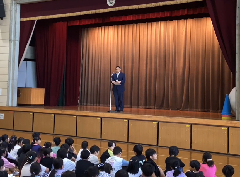
白石副校長先生
みなさんは 大谷翔平を知っていますか?
今年の野球のニュースといえば、二刀流 大谷翔平の言葉が多く聞かれましたね。
ピッチャーとして 10勝、バッターとしては 日本人初のホームラン44本。
最後は、ケガしてしまいましたが、本当にすばらしい成績でした。
大谷選手は、このシーズンを振り返って、
「レギュラーシーズン応援ありがとうございました。また来年に向けてまずは打者としてリハビリから頑張っていきます。来シーズンまた皆さんにお会いできることを楽しみにしています!」
と皆さんに話をしていました。
でも このシーズンは、もっとよい成績を残して、来シーズンにつなげていこうと思っていたに違いありません。
ケガをしてしまい手術もしました。きっと 自分が思い描いていた姿とは程遠いものになってしまったのでしょう。
大谷選手がすごいことは 自分がやってきたことを否定せず、前向きに 次頑張りたいこと 来年に向けての話をしているところです。
私は この話は みなさんの生活にも 同じようなことが言えると思うのです。
学校の授業や休み時間 すべての学校生活の中では自分の思うようにいかないこと やってみたけどうまくいかないことって ありませんか。私は みなさんに 思うようにいかないことや やってみたけどうまくいかないことがあったときに、くじけずに あきらめずに 何度でもチャレンジできる そんな人になってほしい と思っています。
つまり できるようになるために どうしたらよいか 考え 実行できる人になってほしいと考えているのです。今、第三吾嬬小学校が みなさんに 主体性をもって生きていける人になってほしいと 言っていますが まさに 自分で考えて行動できるということは、できるようになるために どうしたらよいか 考え 実行できること なんだと思います。
できる姿を イメージして そのために 自分が 何をするのか よりよい選択ができることにつながります。
毎時間、勉強するときに めあてを書いていますね。そのめあてを達成するために できること 考えてみてください。
また そのめあては もう 分かっているよ と思って 力を抜いてしまう人 いませんか。できていると思っていることや わかっていると思っていることでも 見直すことで 確かな力に変えることができます。みなさんがよりよく成長していこうとする姿 期待しています。お話を終わります。
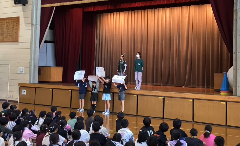
代表委員、スポーツ・フェスティバルスローガン発表
Do you know Shohei Ohtani?
This year's baseball news was full of words about the two-way player Shohei Ohtani. He won 10 games as a pitcher and hit 44 home runs as a batter, the first Japanese person to do so. He was injured before the end of the season, but he had an amazing record. During this season, Ohtani said to everyone, "Thank you for your support during the regular season. I will work hard from rehabilitation as a batter for next year. I look forward to seeing you all next season!" But he must have wanted to achieve better results this season and carry them over to next season. He was injured and had surgery. He must have felt far from the image he had in mind. What is impressive about Ohtani is that he does not deny what he has done and talks positively about what he wants to do next and for next year.
This story can be applied to your life as well. In school classes and breaks, in all aspects of school life, don't you have things that don't go as you want or that you try but don't work out well?
I want you to become someone who can challenge yourself again and again without being discouraged or giving up when you have things that don't go as you want or something that you try but doesn't work out well. In other words, I want you to become someone who can think and act on what you can do to achieve what you want. It is exactly what Daisan-Azuma Elementary School wants you to become: someone who can live proactively. Being able to think and act for yourself means thinking and acting on what you can do to achieve what you want. You can make better choices by imagining what you want to achieve and what you can do for it.
Every hour, you write your goals when you study. Please think about what you can do to achieve those goals. Also, are there any of you who think you already know your goals and relax your efforts? Even if you think you can do or understand something, you can turn it into a solid skill by reviewing it.
I look forward to seeing you grow better.
That's all for today. Thank you for listening.
令和5年10月10日(火曜日) 令和5年度 始業式
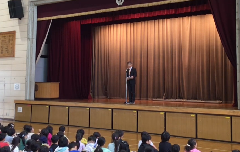
校長式辞
おはようございます。
今日から、令和5年度の後期がスタートします。先週の終業式にもお話ししましたが、今年度、第三吾嬬小学校は皆さんが主体的に学習や生活を頑張れるようになることを目指しています。
今日は後期の始まりに、もう一度、「主体的である」とはどういうことが、確認しておきましょう。
「主体的である」とは、「自分のことは自分で決める」ということです。自分が何をするか、何を言うか。誰かに言われてするのではなく、自分が考えて、すると決めたことをするのです。例えば、教室で先生のお話を聞くときにも、先生が聞きなさいというから聞くのではなく、先生の話を聞いておかないと良くないな、先生の話を聞いておいた方が得だな、と自分で聞こうと思って聞くようにするのが、主体的な聞き方です。家でやる勉強も、おうちの人がやれ、やれと言うからやるのではなく、自分が賢くなるために必要な勉強をするようにできるのが,主体的な学習の仕方です。
皆さんの前期の振り返りに、「漢字が苦手だから頑張って練習したら、満点が取れた」と書いている人がたくさんいました。そうやって、自分で考えて、努力した人は、自分の目標を達成できますね。たとえできなかったとしても、誰かに言われてやったことではなく、自分で決めたことなら、「どこがよくなかったのだろう?」「次はもっと頑張ろう!」と思えるようになるでしょう。自分で決めて行動した人は、どんな結果であっても、決して人のせいにしません。自分の行動に責任をもつ。これも主体的な人の特徴です。
このように「主体的である」とは、私たちの学校教育目標「自立 - 自ら学び、考え、行動する人」のことで、さらに自分の行動に責任をもてる人、ということになります。
さあ、今日から、後期の学校生活が始まります。後期は、スポーツフェスティバルや展覧会、社会科見学や遠足など、楽しい行事もたくさんあります。みんなが、今日から始まる一日一日を、自分で「楽しいものにするぞ!」と決めて、取り組んでいけるといいですね。今日からみんなで頑張りましょう!
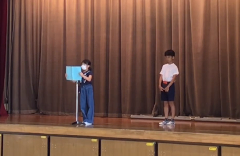
児童代表のことば
Good morning. Today, the second semester of the school year 2023-24 starts. As I told you at the closing ceremony last week, this year, our school aims for you to be proactive. Today, at the beginning of the second semester, let's check again what it means to be proactive.
To be proactive means to decide things for yourself: what you do and say. Instead of doing what someone tells you, you think for yourself and do what you choose. For example, when you listen to the teacher's talk in the classroom, instead of listening because the teacher tells you to listen, you listen because you think that it is not good if you do not listen to the teacher's talk, or that it is beneficial to listen to the teacher. It is a proactive way of listening. Studying at home is also proactive if you can do the necessary study to become smarter instead of doing it because your family tells you to do it. Many of you wrote in your reflections for the first semester, “I was poor at kanji, so I practiced hard and got a perfect score.” Those who think for themselves and work hard can achieve their goals. Even if they couldn’t do it, if it were not something they did because someone told them to do it, but something they decided for themselves, they would think, “What was wrong?” “I'll try harder next time!” Those who choose and act for themselves never blame others for their results. They take responsibility for their actions. It is also a characteristic of proactive people. In this way, being proactive meets our school education goal: “Independence - a person who learns, thinks, and acts independently,” and further creates, a person who can take responsibility for their actions.
Well, today, the school life of the second half begins. The second semester has many fun events such as the Sports Festival, Exhibition, Social Studies Field Trip, and Excursion. I hope that everyone will decide for themselves to make each day that starts from today fun and work hard a it. Let's do our best together from today!
令和5年10月6日(金曜日) 令和5年度前期終業式
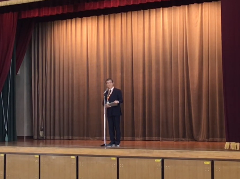
校長式辞
先週から今週にかけて、インフルエンザの影響で学級閉鎖をしていたクラスもありますが、皆さんお元気ですか。
今日は、令和5年度の前半が終わる日です。皆さんは、先日、4月から始まった令和5年度前期の振り返りをしましたね。後で、前期の通知表が担任の先生から渡されますが、私も皆さんが書いた振り返りを読ませてもらいました。皆さんが、この半年の間、どんなことに頑張ったのか、よく書けている人が多く、嬉しく思いました。みんな、よく頑張りましたね。
これまで何度もお話ししてきましたが、第三吾嬬小学校は、「自立・共生・健康」の、三つの目標に向けて、みんなで頑張る学校です。そして、特に今年度は「自立 - 自ら学び、考え、行動する人」を重点目標として、皆さんが主体的になることを目指しています。皆さんの振り返りにも、自分で考えて、自分から進んでいろいろなことに取り組んだ様子が書かれていました。大変素晴らしいことです。
今日、担任の先生からいただく通知表「学習・生活のお知らせ」には、皆さんの振り返りと合わせて、先生からの言葉も書かれています。今日は、家に帰って、おうちの人と一緒にそれを読んで、前期の間、どんなことに頑張って、どんな力がついたか。そして、後期はどんなことを頑張りたいか、などについてお話ししてみてください。
そして、来週から始まる令和5年度の後期も、皆さんがより一層、主体的に学習や生活に取り組むことができるようになることを願います。
(終業式の様子は、「保護者専用ページ」の校長室動画通信でお届けしています。)
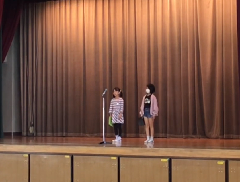
児童代表のことば
Some classes were closed due to influenza from last week to this week, but are you all well? Today is the last day of the first half of the school year, 2023. You all looked back on the first half of the school year, which started in April, the other day. Later today, you will receive a report card for the first semester from your homeroom teacher. I also read your reflections. Many people wrote well about what they worked hard on during this semester, which made me happy. You all did a great job.
As I have told you many times, San-Azu Elementary School is where everyone works hard toward three goals: "Independence, Living Together, and Health." And especially this year, we aim for you to become more proactive by focusing on the goal of "Independence - a person who learns, thinks, and acts independently." Your reflections also described how you thought for yourself and took on various challenges proactively. It is very remarkable.
On the report card, "Report of Learning and Life," that you will receive from your homeroom teacher today, there are also the teacher's words and reflections. Today, when you go home, read it with your family and talk about what you worked hard on, what skills you gained during the first semester, and what you want to work hard on in the second semester, etc. I hope you can take on learning and life more proactively in the second semester, starting next week.
令和5年10月2日(月曜日) 「当たり前を疑う」〜「6カ国転校生」より 川中子校長
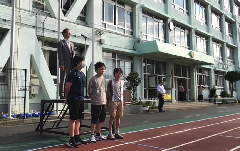
6年代表あいさつ
おはようございます。皆さんは、本を読むのが好きですか? 皆さんは図書館にはよく行きますか? 三吾小の図書館は、この夏休みにレイアウトを変えて、みんなが気持ちよく読書できるようにしました。皆さんの町には、ひきふね図書館という立派な図書館がありますが、行ったことはありますか? 図書館は、とても素敵なところです。私は皆さんがこれから大人になっても、日常的に図書館に行くようになってほしいと願っています。
さて、昨日、私の町の図書館へ行ってみました。そこで、とても素敵な本と出合いましたので、今日は皆さんにその本の紹介をします。本のタイトルは「6カ国転校生 ナージャの発見」といいます。この本を書いた人は、キリーロバ・ナージャさんというソ連・レニングラード、今のロシアのサンクトペテルブルクという町で生まれた女の人です。ナージャさんは、お父さんのお仕事の関係で、6つの国の現地の学校に通いました。小1がロシアの小学校、小2は日本にいて何と京都の幼稚園に通っていたそうです。小3はイギリス、途中からフランス、そして小4で日本、小5でアメリカ、小6でもう一度日本、中1、中2はカナダ、中3は日本の中学校へ通いました。
ナージャさんは、人見知りな性格で、たくさんしゃべって、友達を作ってしまうタイプではありませんでした。そんなナージャさんが、毎年のように次々と別の国の小学校に通って体験したこと、感じたことがその本には書かれていました。それも、どの国のことも、「おかしい」「変だ」ではなく、「面白い!」というふうに捉えていたところに、私はとても感動しました。
本の初めのほうに、ナージャさんからの質問が5つありました。今日は、全部を紹介できませんが、まず、そのうちの一つ、「小学校の筆記用具、どっちを使う? えんぴつ? ペン?」というのを紹介します。皆さんはどっちですか? もちろん、鉛筆ですね。
ロシアの小学校に入学したナージャさんは、ボールペンを使っていたそうです。色は青。鉛筆は図工で絵を描くとき、算数で図形を書く時だけしか使いませんでした。それが、イギリスの学校に転校したとき、みんながえんぴつを使っているのでびっくりしたそうです。初めは、鉛筆で書くことにとても抵抗があって、もやもやしたそうです。鉛筆で書くと、自分の意見を書いている感じがしないし、まだ自分の意見が定まっていないように感じたそうです。でもある日、えんぴつの上に消しゴムが付いていることに気づいて、これは書き直しができる、気を抜いても大丈夫と思ったら、すらすらと書けるようになったそうです。本にはこう書いてあります。「書いたものは、消すことができない自分の意見として永遠に紙に刻まれる。だから、意見もそれなりにしっかりするし、なによりキレイな考え抜いた文章が残る。つまり、『よく考える』を極めた文章になるわけだ。」「書いている途中で間違えたら、もう一度最初から書き直しをしなければならない。だから、よく考えてから書くことを自然と覚えていく。鉛筆を使って、書きやすくするのか、ペンを使って考えやすくするのか、実は書く道具がそのプロセスを決めるのだ。」
そのほか、教室の座席についてもそれぞれの国で違っていて、勉強のやり方がそれぞれの座り方によって違うことに気付いたそうです。ロシアでは、日本のように、先生が前にいて、二人用の長い机に男女で座る席でした。そこでは、先生は教える人で、先生と生徒がやり取りする勉強の仕方でした。それがイギリスに行ったら、日本の給食の時のように、5,6人の人がテーブルを囲み、みんなでおしゃべりしながら勉強していたそうです。初めはびっくりしたけれど、みんなで話し合って考えて、グループで意見をまとめたり答えを考えたりするのは、突然先生にあてられて、答えられなかったらどうしようという心配のないやり方だなと思ったそうです。先生は偉い人、というより、遠い親戚のおじさん・おばさんみたいな感じだったそうです。最近、私たちの学校も、座り方がクラスによって変わってきていますね。ナージャさんはこう書いています。
この本でナージャさんが教えてくれたのは、私たちが普段「当たり前」だと思っていることは、見方を変えれば、案外、当たり前ではないということです。そして、どちらがいい、ということではなく、それぞれの良さを大事にしていくと、私たちはもっと豊かな人生を贈ることができるようになります。「当たり前」を疑ってみること。皆さんには、できますか?
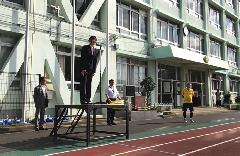
教育実習生あいさつ
Good morning. Do you like reading books? Do you often go to the library? The San-Azu Library changed its layout during this summer vacation so everyone could read more comfortably. There is a splendid library called Hikifune Library in your town, too. Have you ever been there? A library is a very wonderful place. I hope you will go to the library regularly, when grown up.
Well, I went to the library in my town yesterday. I came across a lovely book there, so I will introduce it today. The book's title is "Six Countries Transfer Student: The Discoveries of Nadya." The person who wrote this book is Nadya Kirillova, a woman born in Leningrad, Soviet Union, now St. Petersburg, Russia. Nadia attended six countries' local schools because of her father's work. She went to a Russian elementary school in first grade. Then, she went to a kindergarten in Kyoto, Japan, in second grade. She went to England in third grade, then France, and Japan again in fourth grade. She went to America in fifth grade, Japan again in sixth grade, Canada in seventh and eighth grade, and then to a Japanese junior high school in ninth grade.
Nadya was shy and did not talk much or make friends quickly. In this book, she wrote about what she experienced and felt when she went to different schools every year. She did not see the differences between the countries as "strange" or "weird" but as "interesting." I was very impressed by that.
At the beginning of the book, there were five questions from Nadya. I cannot introduce all of them today, but first, let me introduce one: "Which writing tool do you use in elementary school? A pencil? A pen?" Which one do you use? Of course, it's a pencil.
Nadya used a ballpoint pen when she entered a Russian elementary school. The color was blue. She only used pencils for drawing pictures in art class or drawing shapes in math class. She was surprised when she transferred to a school in England and saw that everyone was using pencils. At first, she was very resistant to writing with a pencil and felt frustrated. She felt that writing with a pencil did not express her opinion well and that her opinion was not settled yet. But one day, she noticed an eraser on top of the pencil and thought that, if she could erase and rewrite, it would be okay even if she made a mistake. Then, she was able to write smoothly. She wrote this in the book: "What you write is engraved on the paper forever as your opinion that cannot be erased. So your opinion becomes solid, and you write beautiful sentences that are well thought out. In other words, it becomes a text that has mastered the art of 'thinking well.'" "If you make a mistake while writing, you must rewrite it from the beginning. So, you naturally learn to think before you write. Whether you use a pencil to make it easy to write or a pen to make it easy to think, the writing tool determines the process."
She also noticed that the seating arrangements in the classrooms differed in each country and that the way of studying differed depending on how they sat. In Russia, it was like Japan; the teacher was in front, and they sat together at long desks for two people, boys and girls. There, the teacher was the one who taught, and they studied by interacting with the teacher. But when she went to England, they sat around a table with five or six people and learned while chatting. She was surprised at first, but she thought it was a good way of studying as she did not have to worry about being suddenly asked a question by the teacher and being unable to answer. She felt the teacher was not an authority figure, but more like a distant relative, like an uncle or aunt. Recently, our school also has different seating arrangements depending on the class.
Through this book, Nadya taught me that what we think is 'normal' is not necessarily normal when we change our perspective. The important thing is not to judge which one is better but to value the good points of each one; that way, we can live a more prosperous life. To doubt 'normal;' can you do that?
令和5年9月 September 2023
令和5年9月25日(月曜日) 「友達と協力すると」 2年担任HR先生 Monday, Sep. 25th, 2023 "If you cooperate with friends, ...?!" by Ms. H.R., a second-grade teacher
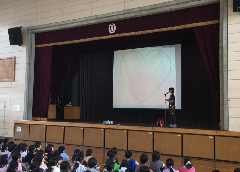
H先生
2年1組では、「ありがとうの木」という取り組みをしています。(木の絵を見せて)こんな風に、クラスメイトの素敵なところ、ほめたいところを、ハートの紙に書いて、木の上に貼ります。ですが、最近ハートが少なくなってきてさみしいなと思ったので、私はハートをたくさん作って木の宣伝をしようかと思いました。
さて、皆さんだったらどうやってハートを作りますか? まず、一つ目。こんな方法を思いつきました。画用紙にハートを書きました。そして、切ってハートを作りました。二つ目の方法は思いつきますか?紙を半分に折って、半分のハートを書いて、切ってみました。それを広げると、こんな感じにハートができました。他にも作り方はありますか? 三つ目の方法は、紙を半分の半分に折って、ハートを書いて切ってみました。すると、こんな形になりました。これを重ねてみると、四つ葉のクローバーの形になりました。他にも作り方はないかなと考えていたところ、クラスの一人の子が折り紙でハートを作っていました。その子はあまりにも折るのが速すぎて私はまったく分かりませんでしたが、後で教えてもらおうと思いました。
こんな風に一人では思いつかない方法も、友達や先生がいると「あっ、こんな方法もあるんだ!」「この方法からなら、あの方法でもできそうだな。」などと、いろいろな方法が思いつくかなと思います。私は、皆さんが学校で勉強する理由というのは、これじゃないかなと思っています。一人では分からないことも友達と力を合わせて協力するといろいろな方法で解決できますね。
さて、私も2年2組のみんなといろんな方法でハートを作ってみようと思います。もし興味があったら、やりに来てください。これで終わります。
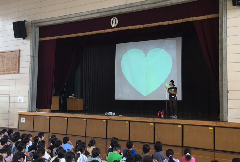
ハートの作り方
In my class, 2-2, we have a project called "Thank You Tree." (showing a picture of a tree) Like this, we write our classmates' remarkable and praiseworthy aspects on heart-shaped papers and stick them on the tree. However, the number of hearts has recently decreased, and I felt sad. I thought about making a lot of hearts and promoting the tree.
Now, how would you make a heart? First, one method that came to mind is drawing a heart on construction paper. Then, cut it out to make a heart.
Can you think of another method? Second, I tried folding the paper in half, drawing half of the heart, and cutting it out. When I opened it up, it looked like this.
Are there any other ways to make a heart? For the third method, I folded the paper in half again, drew a heart, and cut it out. As a result, it took this shape. When I stacked them together, it looked like a four-leaf clover. While thinking if there were any other ways to make hearts, one of my students was making hearts with origami. The student was folding so fast that I couldn't understand how to fold it. So, I decided to ask later.
In this way, you may not develop different methods when you are alone. However, when you have friends or teachers around you, various methods may come to mind, like "Oh, there is such a method!" or "From this method, it seems possible to do that method." I think that's why you study at school. By cooperating with friends when you don't understand something alone, you can solve problems in various ways.
I will make hearts with everyone in 2-2 using various methods. If you're interested, please come and join us. That's all for now. Thank you for listening.
令和5年9月19日(火曜日) 「秋ー栗のお話」 1年担任I.Y.先生
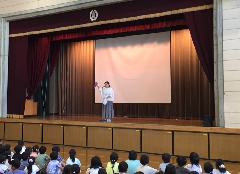
栗をもってきたI先生
おはようございます。毎日、暑いですが、9月になって、徐々に秋が近づいてきました。私は週末、秋を見つけてきました。今から、皆さんにその「秋」を見せて、今日はその話をします。この袋の中からそれを取り出すのですが、ちょっと怖いです。何が入っているでしょう? このハンカチの中に入っていたのは、栗です。周りのイガがブツブツしているので、そのまま触るとちょっと痛いです。だからハンカチを使って、もっています。
私は栗拾いをしてきたのですが、皆さんは栗拾いをしたことはありますか?ある、という人は手を挙げて。ああ、少ないですね。私は、子どもの頃、家の前に栗の林があったので、よく栗拾いをしていました。今回も栗拾いをしたくなったので行ってきました。
実は、この、栗なんですが、すごく昔から日本にあります。縄文時代、9000年くらい前にはこの栗を食べていた人がいたそうです。
では、今日は、栗についての問題を出します。1番。日本で栗が一番多く収穫されているのはどこでしょうか。1)岐阜県。2)熊本県。3)茨城県。どれでしょう。正解は、3)の茨城県でした。では、次の問題。2番。栗は木になっているので果物です。果物には種がありますね。栗の種はどれでしょう?1)この、茶色いのが種?2)この茶色の中の黄色いのが種?3)これごと全部が種? 正解は、2)この、殻の中に入っているのが種なんですね。皆が食べているのは、種の部分です。最後の問題です。栗はこのイガイガの中に入っています。一般的には、このイガの中に何個入っているでしょう。2個?3個?4個?5個? 正解は、一般的な栗には、3個入っています。
先程、栗拾いをしたことがないという人がいたので、イガに入っている栗をもってきました。触るとチクチクして痛いです。触ったことない人のために、1年1組の前に置いておきますので、触ってみてください。これでお話を終わります。
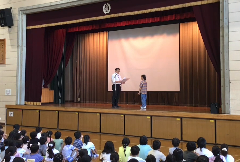
表彰も行いました
Good morning. It's hot every day, but since September arrived, autumn has been gradually approaching. I found autumn over the weekend. I will show you that "autumn" now and talk about it today. I'm going to take it out of this bag, but it's a little scary. What do you think is inside? What was in this handkerchief was a chestnut. The surface of the chestnut is bumpy, so it hurts a little if you touch it directly. That's why I'm holding it with a handkerchief.
I went chestnut picking, but have you ever done chestnut picking? If you have, please raise your hand. Oh, there are only a few of you. When I was a child, there was a chestnut forest in front of my house, so I often went chestnut picking. I wanted to go chestnut picking again this time, so I went.
These chestnuts have been in Japan for a very long time. People were eating these chestnuts about 9,000 years ago during the Jomon period.
Now, I will give you some questions about chestnuts today. First question: Where are the most chestnuts harvested in Japan? 1) Gifu Prefecture 2) Kumamoto Prefecture 3) Ibaraki Prefecture. Which one do you think is correct? The correct answer is 3) Ibaraki Prefecture. Now, the next question: Chestnuts grow on trees and are therefore fruits. Fruits have seeds. Which one do you think is the seed of a chestnut? 1) Is this brown one the seed? 2) Is the yellow one inside this brown one the seed? 3) Are all of these together the seed? The correct answer is 2) The one inside this shell is the seed. What we eat is the seed part. Here's the last question: Chestnuts are inside these spiky shells. How many are generally inside this shell? Two? Three? Four? Five? The correct answer is that there are generally three chestnuts inside.
Some of you had never gone chestnut picking, so I've brought some chestnuts in their shells. It's prickly and hurts when you touch it. For those who haven't touched it before, I'll leave them in front of class 1-1 for you to touch. That's all for my story.
令和5年9月11日(月曜日) 「人権の花」について 3年担任・OY先生
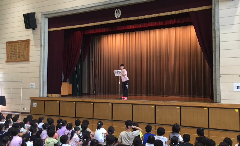
O先生
3年担任のOです。今日は、「人権の花」についてお話しします。
「人権の花」って何か、知っている人はいますか? みんなの頭の上に、?マークが浮かんでいるようです。今、福祉ボランティア委員会の人たちが、1年生の玄関の前でお花を育てています。マリーゴールドとヒャクニチソウというお花を育てています。
では、「人権」って何か分かりますか。ちょっと難しい言葉ですね。人権とは、みんな一人一人が、自分らしく生きていく権利のことです。ちょっと難しいですね。
では、今度はお花についてクイズを出します。世界中にはいろいろなお花があります。例えば、今紹介したマリーゴールドやヒャクニチソウ。1年生は朝顔を育てていたんじゃないかなと思います。では、世界中にお花は何種類あるでしょうか? 1)300種類。 2)もっと多い? 20,000種類くらいある。 3)いや、もっと多い? 200,000種類くらいあるんじゃないかな? では、1)2)3)のどれだと思いますか? 答えは、3)200,000種類。すごくたくさんの種類があるんだそうです。
では、人権の話に戻ります。お花は200,000種類、いろいろなお花があります。同じ種類のお花でも、例えば、朝顔。同じ朝顔でも、紫色の花が咲いた人もいるし、青い花が咲いた人もいるんじゃないでしょうか。それぞれ花によって、色とか形が違いますね。実は、人間も同じです。みんな一人一人が違う考え方をもっていて、いろいろな人がいます。「人権の花」っていうのは、一人一人の違いを認め合いながら、思いやりながら生活していきましょう、という思いが込められています。
実はこの人権に関するポスターが3階と4階の間の踊り場の掲示板に飾ってあります。ぜひそのポスターを読んでみてください。これでお話を終わります。
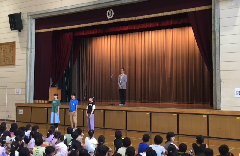
6年生代表の挨拶
I'm O.Y., a third-grade teacher. Do you know what the 'Flower of Human Rights' is? Many of you have a question mark floating above your head. The Welfare Volunteer Committee is currently growing flowers in front of the entrance for the first-grade students. They are growing marigolds and zinnias. Do you know what 'human rights' are? It's a bit of a difficult word. Human rights refer to the right of every person to live as themselves. It's a bit difficult, isn't it? Now, I'll give you a quiz about flowers. There are many different kinds of flowers all over the world. For example, the marigolds and zinnias that I introduced earlier. First graders might have grown morning glories. How many types of flowers do you think there are in the world? 1) 300 types, 2) More than that? Around 20,000 types, 3) No, more than that? Around 200,000 types. Which one do you think it is? The answer is 3) 200,000 types. There are so many different kinds of flowers. Now, let's go back to human rights. There are 200,000 types of flowers, many different kinds of flowers. Even if they are the same kind of flower, for example, morning glories, some people might have grown purple flowers while others might have grown blue ones. Each flower has different colors and shapes, right? Humans are the same way. Everyone has different ways of thinking and there are many different kinds of people. The 'Flower of Human Rights' is a symbol that represents living together while recognizing each other's differences and living with compassion. A poster about human rights is on the bulletin board between the third and fourth floors. Please read that poster if you get a chance. That's all for my talk. Thank you for listening.
令和5年9月4日(月曜日) 「東京都の小さな島・青ヶ島について」 K.N.栄養士さん
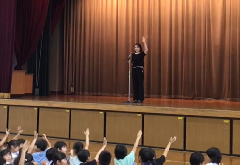
K.N.栄養士さん
皆さん、おはようございます。皆さん、もう私の顔は覚えてくれましたか。皆さんが給食を食べているときに、様子を見に行っている栄養士のKです。
今日から給食が始まりますね。皆さん、楽しみにしてくれていますか? 今日のメニューは何か知っていますか? 今日はカレーライスです。給食を楽しみに、4時間目まで頑張ってください。
今日は、私がこの学校に来る前にいた学校についてお話ししたいと思います。私は、東京都にある小さな島、青ヶ島の学校に勤めていました。知っている人もいますね。すごく小さな島なんですが、そこに住んでいる人が何人くらいいるか、クイズを出します。1)530人。今、この学校の子供の数と同じくらいです。 2)320人。 3)170人。1)だと思う人は手を挙げてください。 2)? 3)? 正解は、3)の170人です。170人と言えば、1年生と2年生を合わせたくらいです。とっても小さい島です。小学校と中学校があったんですが、合わせて15人くらいしかいませんでした。すごく小さな学校です。私はそこの給食を作っていました。先生を合わせても35食くらい。3年生、一クラスの人数くらいですね。食材は、毎日新鮮なものを使っていましたが、島ですから舟で運ばれてきます。舟は週に4回か5回しか来ません。そのうちの半分くらいは海が荒れて、舟が来ない日もあります。ですから、食材が届かないこともたくさんあります。そういうときはどうするかというと、私は、島の人で野菜を育てている人に電話をかけて、「お野菜、何かありませんか?」って聞いて、「今日はキャベツがあるよ」って言われたら、それからキャベツを使った料理を考えて給食を出していました。そのように、給食のメニューが突然変わることがありました。この学校では、突然変わることはありません。そうやって、島の人たちと仲良くなってやってきました。
青ヶ島にはないものがいっぱいあるんです。例えば、皆さんの近くにはコンビニがたくさんあります。お母さんが、何か足りないって言うと、コンビニで買うことができますね。そういうのは青ヶ島にはないので、買い物は雑貨屋さんでよる7時半までしかかうことができません。皆さんはゲームセンターが好きかもしれませんが、ゲームセンターもありません。マクドナルドもありません。最初、島に行った頃は、食べたいものも食べられないし、見たい映画も見られませんでした。でも、青ヶ島の村長さんが、「青ヶ島にしかないものがたくさんあるよ。」って教えてくれたんです。例えば、青ヶ島の夜は、外がとっても暗いので、たくさんの星を見ることができます。流れ星も、1日に10個くらい見られます。周りの全部が海なので、とってもきれいな景色が見られます。島の人はとっても優しいので、すれ違うとき「こんにちは。」って皆さん挨拶してくれます。すれ違うとき、「今日は大根があるよ。」っていって、大根をもらったりもしました。島の人たちはとっても仲良しです。ちょっと不便なところでしたので、こっちの生活が何てすばらしいんだろうって思うようになりました。給食も皆さん、毎日当たり前に食べていますが、創ってくれている人や、食材を育てている人がいるっていうことを覚えておいてください。今日からの給食もいっぱい食べてもらえたら嬉しいです。
青ヶ島のことも、ぜひ調べてみてください。これで終わります。
Monday, September 4th, 2023 "Aogashima, A Small Island in Tokyo" by Ms. K.N., the nutritionist
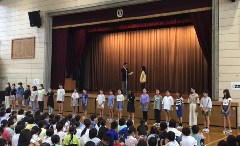
お話の後、表彰も行いました
Good morning, everyone. Have you remembered my face yet? I am K, the nutritionist who comes to check on you while you eat your school lunch. Today is the first day of school lunch in September. Are you looking forward to it? Do you know what's on the menu today? It's curry and rice. Please work hard until the fourth period while looking forward to your school lunch.
Today, I would like to talk about the school I worked at before coming to this school. I worked at a school on a small island called Aogashima in Tokyo. Some of you may know it. It's a very small island, but can you guess how many people live there? Here's a quiz for you: 1) 530 people. That's about the same number of children in this school now. 2) 320 people. 3) 170 people. Those who think it's 1), please raise your hand. 2)? 3)? The correct answer is 3) 170 people. Speaking of which, that's about as many people as the first and second graders combined. It's a very small island. There was an elementary and junior high school there, but there were only about 15 students in total. It was a very small school. I made school lunches there. Even with the teachers, there were only about 35 meals. That's about the number of students in one class in the third grade. We used fresh ingredients every day, but, since it was an island, they were brought by boat. The boat only comes four or five times a week. Half of those days the seas are rough and there are days when the boat doesn't come at all. So what do we do when that happens? I would call someone on the island who grows vegetables and ask them if they had any vegetables available and if they said "We have cabbage today," I would think of a dish using cabbage and serve it for lunch. That's how the menu for school lunch would suddenly change sometimes.
There are many things that Aogashima doesn't have. For example, there are many convenience stores near where you live. If your mother says something is missing, you can buy it at a convenience store, right? But Aogashima doesn't have that, so shopping can only be done at a general store until 7:30 p.m. You might like game centers, but there are no game centers either. There is no McDonald's either. At first, when I went to the island, I couldn't eat what I wanted or see the movies I wanted to see either. But the mayor of Aogashima told me that "There are many things that can only be found on Aogashima." For example, at night on Aogashima, it's very dark outside so you can see lots of stars. You can see about ten shooting stars a day too! Since everything around you is sea, you can see very beautiful scenery too. The people on the island are very kind too, so when we pass each other they say hello and greet us all kindly. When we pass each other they say "We have radishes today!”and sometimes give us radishes too! The people on the island are all very friendly with each other.
It was a little inconvenient there so I started thinking how wonderful life here is instead.
Please remember that there are people who make school lunches and grow ingredients every day that everyone eats as a matter of course. I would be happy if you could eat a lot of today's school lunch.
Please also look up Aogashima later. That's all. Thank you for listening.
令和5年9月1日(金曜日) 「今日からの学校生活について」 川中子校長 Friday, September 1st, 2023 "About The School Life from Today" by Principal Kawanago
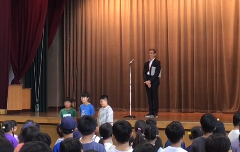
6年生代表
おはようございます。
長い夏休みが終わって、今日から前期後半が始まりました。皆さん、元気に過ごせましたか?
今年の夏休みも、本当に暑い日が続きました。夏のプールも残念ながら中止になった日もたくさんありましたね。
そんな暑い暑い夏休みでしたが、皆さんは、どんなふうに過ごしていましたか。
私は、この夏は一つ、特別なことがありました。私には4人の娘がいますが、そのうちの一番上の子が、この夏結婚しました。それで、軽井沢の教会で結婚式に出ました。軽井沢は長野県にありますが、東京から新幹線で1時間くらいのところで、とても涼しくて、1日のうち一番熱い時間帯でも、東京の一番涼しい時よりも涼しく、とても過ごしやすい陽気でした。両方の家族でお祝いをして、とても素敵な時を過ごすことができました。
後は、本を読んだり、勉強会に参加したり、結構忙しく過ごしていました。
今年はコロナの規制もなかったので、三吾小の地域でも、ラジオ体操や盆踊りも行うことができ、楽しい思い出ができましたね。
皆さんも、たくさんの楽しい思い出ができたことと思います。
今日からの学校は、行事もたくさんあり、皆さんが活躍できる場がいっぱいあります。5年生は、初めての宿泊行事が今月末にあります。10月には体育学習発表会、11月には展覧会もあります。また、各学年、社会科見学などの学習もあります。楽しみですね。皆さんには、主体的に、自らすすんでそれらの行事にも参加して、楽しんでほしいと思っています。そのため、みんなが考え、みんなでよく相談してやることも決めたいと思っています。先生が決めてしまうのではないのですよ。自分たちがこんなことがしたい、こんな風にやりたい、と思うことを考えてみてください。勉強もそうですよ。先生に教わるだけでなく、自分たちで考えたり、調べたり、友達と一緒に学習したりしてほしいと思います。学校は、皆さんのものです。先生たちは、そんな皆さんの頑張りを応援しています。楽しい学校にしていきましょう。
最後に、今日、9月1日は、この東京に大きな、大きな被害をもたらした関東大震災からちょうど100年目の日を迎えました。皆さんが暮らしている墨田区でも、びっくりするほどたくさんの方が犠牲になりました。今日は、各教室でその地震がどんなものだったのか、今、皆さんにできることは何かを先生と一緒に考えてほしいと思います。
それでは、今日から、元気に頑張っていきましょう!
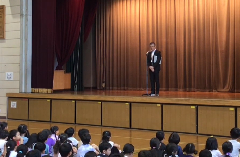
「特別な夏でした」
Good morning. The second half of the first semester has started today after a long summer vacation. How have you been? This summer was sweltering, and there were many days when the swimming lesson was unfortunately canceled. How did you spend such a hot summer vacation?
I had one special thing this summer. I have four daughters, and my eldest daughter got married this summer. So I went to her wedding at a church in Karuizawa. Karuizawa is in Nagano Prefecture, about an hour by Shinkansen from Tokyo. It was very cool and comfortable even during the hottest time of the day, cooler than the coolest time in Tokyo, and we could spend a lovely time celebrating with both families. After that, I read books and participated in some study sessions, and I was pretty busy. This year, there were no restrictions due to Corona, so we could do radio exercises and Bon dances in our school area and have some fun memories. I think you also had many fun memories.
There are many events at school starting today and many opportunities for everyone to shine. The fifth graders will have their first overnight trip at the end of this month. There will be a Sports Day in October and an Exhibition in November. Also, each grade has social studies trips and other learning opportunities. It’s exciting, isn’t it? I want everyone to participate in these events actively and enjoy them. Therefore, I would like everyone to think about what they want to do and how they want to do it by discussing it together. It’s not the teacher who decides everything. Please think about what you want to do and how you want to do it. That’s the same for studying too. I hope you will not only learn from your teachers but also think for yourselves, research on your own, study with your friends, etc. The school belongs to all of you. The teachers support your hard work like that. Let’s make it a fun school.
Finally, today is the 100th anniversary of the Great Kanto Earthquake, which caused a lot of damage in Tokyo on September 1st one hundred years ago. Many people were also victims in Sumida Ward, where you live. Today, I hope you will think with your teacher about what kind of earthquake it was and what you can do now.
Well then, let’s work hard from today!
令和5年7月 July 2023
令和5年7月18日(火曜日) 「血液型について」 5年担任Y.Y.先生 Tuesday, July 18th, 2023 "About Blood Types" by Ms. Y.Y., a fifth grade teacher
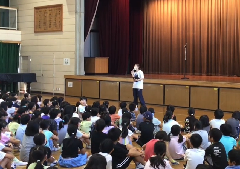
Y先生
A・B・O・ABと聞いて当てはまるものは何ですか。そうです、血液型ですね。今日は血液型に関係する話を4つお話しします。
(1)割合
日本人の人口を100%にしたとき、A型が40%、O型が30%、B型が20%、AB型が10%と言われています。
また、世界ではO型が一番多いと言われていて、メキシコは85%がO型です。
(2)血液型を知らない?
日本では生まれたときやアレルギー検査で、血液型を調べる機会がありますが、外国ではそういう機会はないそうです。アメリカ人は自分の血液型を知らない人が多い!ちなみに私は16歳になるまで知りませんでした。
(3)血液型で性格が決まるわけじゃないという話
A型は真面目、AB型は変わった人が多い・・・こういう話はよく聞くと思いますが、じつはこういうことは日本人しか言っていないソウです。血液型と性格にはあまり関係はないと言われています。
(4)黄金の血液
「黄金の血液」というのがあるそうです。この前テレビを見て、初めて知ったので調べてみました。
それはAでもBでもOでもABでもなくて、A・B・O・ABでもある幻の血液型だそうです。
世界に50人ほどしかいないと言われていて、日本人にも1人いるそうです。黄金の血液の何がすごいか・・・病気や事故で血が足りなくなってしまった時に、A型の人は、A型の人の血じゃないと輸血というものができないところ、黄金の血液の人のものはA・B・O・ABどの人にも血をあげられるのです。
皆さんは「献血」って言葉を聞いたことありますか。スカイツリーの下だったり錦糸町の駅の近くなどで「献血コーナー」と書かれたテントを見たことがありますか。献血は、病気や事故で血が足りなくて困っている人たちに協力できます。皆さんも、16歳からできるので自分でも調べてみてください。
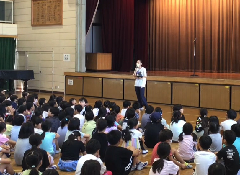
血液型と性格は関係ありません
What do you recall when you hear "A," "B," "O," and "AB"? Yes, they are blood types.
I'm going to talk about the blood types today.
1 The Rate
Among the whole population in Japan, it is said that 40% is A, 30% is O, 20% is B, and 10% is AB. The O is the most common in the world. In Mexico, 85% is said to be O.
2 Knowing My Own Blood Type
In Japan, we usually can examine our blood type when we are born or in an allergy test. In America, most people do not know their own blood types. I hadn't known my blood type until I was sixteen.
3 Blood Type Doesn't Tell Characters
Japanese people often say that type A is serious, type AB is peculiar, etc. That's heard only in Japan. They say there's no relation between one's blood type and character.
4 Golden Blood
There are only a few people in the world who are not any type of the four. The rare blood type is "A, B, O, AB." There are only 50 in the world and one in Japan. Those people can give a blood transfusion to anybody.
Do you know about blood donation? You've probably seen a tent saying 'Blood donation Corner' under the Skytreem or in front of a big station like Kinshicho. You can donate your blood when you become sixteen. The donated blood is used for sick people or injured people who don't have sufficient blood.
令和5年7月10日(月曜日) 夏休みの交通安全のお話 (向島警察署) Monday, July 10th, 2023 About Traffic Safety during Summer Vacation by a police officer from Mukojima Police Station
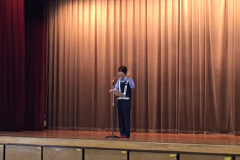
交通課のおまわりさんから
本日は、向島警察署の方に、夏休みの交通安全についてお話しいただきました。(保護者専用ページにてお届けします。)
そのほか、転入生の紹介、フラの表彰を行いました。
Today we had a police officer from Mukojima police station, who talked about traffic safety during the summer vacation. (You can watch the motion picture on the parents' only site.)
(Also, a new student introduction and a commendation for a hula competition)
令和5年7月3日(月曜日) 「自分自身のリーダーになり、自由を勝ち取る」 川中子校長 Monday, July 3rd, 2023 "To become the leader of yourself, and win liberty" by Principal Kawanago
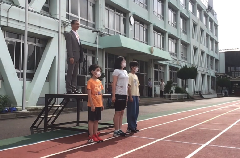
6年生代表のあいさつ
先週、6年生といっしょに日光に行ってきました。1年生が出発前にてるてる坊主を作ってくれたおかげで、梅雨時にしてはよい天気に恵まれ、特に二日目のハイキングや遊覧船クルージング、キャンプファイヤーの時は快晴で、とても楽しく過ごすことができました。
その6年生に、出発の時に話したお話を皆さんにもお話しします。皆さんが幸せになるためのヒントのお話です。
今、学校は皆さんに主体的になってほしいと思い、さまざまな取組を始めています。主体的になるっていうのは、教育目標の「自立 自ら学び、考え、行動する人」のことですね。
なぜ、主体的になるのが大切かというと、自分でどうしたいのか、どうなりたいのかを決められないと、皆さんはいつまでたっても他の人や物事に縛られて、何をするにしても、いやいややらなければならなくなります。皆さんはよく、「勉強しなさい。」とか「宿題をやりなさい。」とか言われることがありますよね。ほかにも、「早くしなさい。」とか「○○しなさい」と言われることがあるでしょう。そんなふうに言われた時はどんな気持ちがしますか。そうやって、いつも、おうちの人や先生、他の友達に言われたことに従わなければならないのはどうですか? 檻に閉じ込められたみたいで、何だかいやですよね。そうなのです。自分で考えて、決められるようにならないと、私たちは自由になれないのです。逆に、人に言われてやるのではなく、自分で決めてやるようになると、私たちは自由になります。何かに縛られたり、閉じ込められたりしている間は、私たちは幸せにはなれません。マスクもそうですよ。マスクをしている間は、幸せになれないんです。幸せになるためには、私たちは自由を勝ち取らなければならない。そのために、私たちは、自ら学び、考え、行動する人にならなければならないのです。
ところで、何が私たちを縛っているのか、私たちを閉じ込めているのは何なのか、わかりますか? お父さん、お母さん? 先生? 友達の誰かですか? 違うんですよ。実は自分を縛っているのは、自分自身です。だから、私たちは自分自身で決める、自分のリーダーにならなければなりません。自分で決められるようになったら、皆さんは自由になり、幸せをつかむことができるようになるでしょう。主体的になってください。そして、自分自身のリーダーになってください。
話は変わりますが、今週の土曜日、3年生以上の皆さんに道徳の授業で映画を見てもらうことにしました。「みんなの学校」という、大阪にあるある小学校の様子を紹介する映画です。みんなと同じ小学生が主人公の学校の様子を記録した映画です。子供向けの映画ではありませんので、ちょっと難しいところもあるかと思いますが、どんな学校なのか、三吾小と比べてどうかなど、考えてみてほしいと思います。
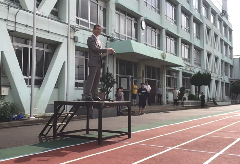
自由を勝ち取るのです!
I went to Nikko with the sixth graders last week. Thanks to the first graders, who made us 'Teru teru boze (a handmade doll for wishing for good weather),' we could have good weather during the rainy season. Especially on the second day, it was fine, and we could enjoy hiking, pleasure cruiser cruising, and a campfire.
Today, I'll talk about the same topic I talked to the sixth graders about on the first day of our trip. I'll show you some clues to become happy.
Our school has started a variety of projects to make you proactive. Being proactive means being like a person described in our school's educational goals: 'Independence - A person who learns, thinks, and acts independently.'
Why is it so important to be proactive? That's because if you cannot decide what you want to do and how you want to be, you will have to do everything unwillingly while being bound by other people or things. Are you often told, "Study hard!" or "Do your homework?" Or "Do it quickly!" Do this and do that? How do you feel when you are told things like that? How would you feel if you obey your parents, teachers, and friends? Wouldn't it be like being in jail? You won't be free. So, it would be best to decide what to do for yourself. If you can decide for yourself, you'll be free. We won't be happy when we are bound or put in jail by something. You know, it's like with your masks, too. You may not be able to be happy while wearing your masks. To be happy, we must win our liberty. For that, we must be a person who learns, thinks, and acts independently.
By the way, what binds us, and what puts us in jail? Is it your parents? Your teachers? Your friends? No. What binds us is ourselves. That's why we must be our leaders of ourselves, who can decide what to do. If you can decide for yourselves, you'll be free and happy. So, be proactive! And be the leaders of yourselves.
Here's some news. We'll have a Saturday Open Day this weekend. I want you, the third and older graders, to watch a movie in moral education class. It's a movie about a public elementary school in Osaka, titled "Everyone's School." It's a documentary movie in which the students like you are the main characters. Although it's a little difficult because it's not a children's movie, I want you to watch it and consider the differences between that school and ours.
令和5年6月 June 2023
令和5年6月26日(月曜日) 「怒り」について 1年担任S.N.先生 Monday, June 26th, 20223 "About ANGER" by Ms. S.N., a first-grade teacher
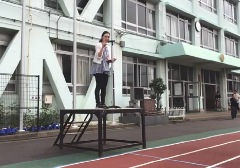
S先生
おはようございます。今日は1年2組のSがお話しします。
私は、校内にはってあるポスターを見ながら歩くのが大好きです。先日まで、保健室の前にはってあったポスター、何だったかわかる人いますか。実は、「怒り」についてのポスターがはってありました。今日は「怒ること」「怒り」についてのお話をします。
怒り、というのは、自分や家族が危険にさらされたとき、自分の意見が通らず思い通りにならなかったとき、自分の大切にしている考えを傷つけられたときに現れる当たり前の感情だそうです。なので、我慢するのは、心にはよくないことですね。でも、ずっと我慢していたり、いきなり怒ったり、ずっと怒っていたりするとどうでしょう。皆さんが心の中にある楽しい気持ちとか、幸せな気持ちが、怒りに支配されて押しつぶされてしまいますよね。また、周りの人から見たらどうでしょう。「怖いな」と思われるかもしれません。 私はある本を見つけたので紹介します。「怒りたくなったらやってみて」という本です。もう一冊は「君の心を強くする本」です。今日は、こっちの「怒りたくなったらやってみて」という本の中から紹介したいと思います。この本の主人公は、ユニコーンの子供ですが、ガストンといいます。ガストンの身に、ガストンにとってとってもいやなことがたくさん起こります。その続きを読みますね。「怒りの雲を追い出す方法、みんなも一緒にやってみてください。まず、目をつぶって、頭の中の大きな雲のことを考えて、鼻から息を吸い込んでおなかを膨らまそう。手はげんこつにして、体に沿ってうでを垂らす。2、息を止めて、素早く肩を動かそう。上と下に2,3回。頭の雲の中に怒った気持ちをぎゅっと閉じ込めるんだ。3,肩と手の力を抜いて、口から息を思いっきり吐き出す。大きな怒りの雲を追い出すんだ。この息の仕方を3回、繰り返そう。ほら、もう追い出せたよ。頭の中に、お日様がキラキラ。」今日はここまで。こちらの、「君の心を強くする本」にはこれとは違う、怒りの雲の追い出し方が書いてあります。もし気になる人がいたら、私のところまで来てください。みんなで、怒りとの付き合い方。いい方法を見つけられたらいいなと思います。これでお話を終わります。
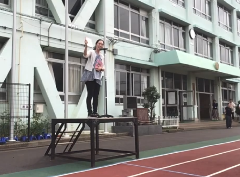
絵本の紹介
Good morning. I'm going to talk to you today.
I like to walk through the corridors looking at the posters on the walls at school. Who knows what poster was on the wall in front of the school nurse's room? It was a poster about 'anger.' So, I'll talk about being angry; anger.
Anger is a natural emotion we have when our family and we face danger; when something doesn't go as well as we thought; and when someone hurts our precious thoughts. That's why it's not very good for our hearts to suppress our anger. However, what do you think about suppressing about for a long time, expressing anger abruptly, and being angry endlessly? Your pleasant and happy feelings in your heart would be smushed down. How about other people watching us be angry? They might be scared.
I found some good picture books, which I'll introduce to you. This is "Just Try This When You Feel Anger." The other one is "The Book That Makes Your Heart Strong." I'll read some from "Just Try This When You Feel Anger." The main character is a child unicorn whose name is Guston. Many unpleasant things happened to Guston. I'll read some. "Just try the method to calm down your anger:
Close your eyes and think about a big cloud. Breathe deep from your nose and inflate your tummy. Make strong fists, and put your arms down.
Stop breathing and move your shoulders quickly, up and down, two or three times. Lock your anger in the big cloud in your mind.
Release the tension from your shoulders and fists. Breathe out from your mouth. Drive away your big cloud of anger.
Try this breathing three times. Look! You've done it well! The sun shines brightly in your mind now!" I'll stop around here. In "The Book That Makes Your Heart Strong," there is another method to drive away your anger. If you're interested, please come and ask me. I hope we can find suitable methods to get along with our anger together.
That's all for today. Thank you for listening.
令和5年6月19日(月曜日) 「水泳」 6年担任・N.N.先生 Monday, June 19th, 2023 "Swimming" by Mr. N.N., a sixth-grade teacher
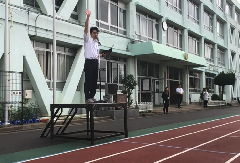
N先生
今週から水泳の学習が始まります。この間まで汚れていたプールもとてもきれいになりました。運動委員の人もお手伝いをして、準備をすることができました。今日は、水泳の話をしたいと思います。
まず、水泳の学習、プールに入ることが好きだよという人、手をあげてください。
1,2,3年生が多いかな? 手を下ろしてください。
少し苦手です、っていう人は? やっぱり、いますね。
人が泳ぐようになったのは、すごく昔からです。ただ、今みたいに、速さを競う用になったのは、けっこう最近みたいです。そして、速さを競う競技になってからは、泳ぎ方が何種類かに決まりました。では、ここで問題です。オリンピックの競技では何種類の泳ぎ方があるでしょう?
1 2種類
2 3種類
3 4種類
さあ、どれだと思いますか。正解は、4種類です。
皆さんもよく知っているようですね。泳ぎ方には、クロール。平泳ぎ。そして背泳ぎ。ここで次の問題です。後1種類の泳ぎ方は、ある生き物の英語の言い方になっています。 1 かえる
2 ちょうちょ
3 さめ
さあ、どれでしょうか。正解は、ちょうちょ! ちょうちょは英語でバタフライって言いますね。4種類目の泳ぎ方はバタフライという泳ぎ方です。バタフライという泳ぎ方を知らない人は調べてみてください。けっこう難しい泳ぎ方です。
このように、クロール、平泳ぎ、背泳ぎ、バタフライの4種類の泳ぎ方がありますが、最初から4種類あったわけではなくて、順番に生み出されてきました。では、最後の問題です。今の4種類の泳ぎ方で、一番古くから泳がれている泳ぎ方はどれでしょう?
バタフライじゃないかなと思う人?
背泳ぎ?
平泳ぎ?
クロール? これが一番多いかな?
正解は、平泳ぎ! 平泳ぎって知ってますか? 知っている人はイメージができるかもしれませんが、人は最初、動物の犬かきって知ってますか? その犬かきから平泳ぎが生まれました。その後、背泳ぎが生まれて、クロール、バタフライの順に生まれてきたそうです。
最後に、私のお話をします。私は小学校の時、体育がとても大好きでした。だけど、体育の中でも、水泳の学習は少しいやでした。水泳だけはとても苦手でした。だから、水泳の時間が余り好きではなかった。だけど私は、できないものがあるっていうのがいやで、それから練習をつづけました。中学校でも、高校でも、大人になってからも。今は水泳がとっても好きになりました。だから夏が来て、プールには入れるなって思うとうれしくなります。
皆さん、「継続は力なり」って言葉知ってますか? 「継続」っていうのは「続ける」って言うことです。「力なり」って言うのは、「成功する」って言う意味です。人は、続けて努力することによって、いろんなことができるようになるよ、っていうことわざです。皆さんの中にも、苦手な人はいると思います。得意な人もいると思います。この水泳の学習で、好きになったり、得意になったり、上手になったりできる人が一人でも増えてくれるといいなと思っています。
これでお話を終わります。
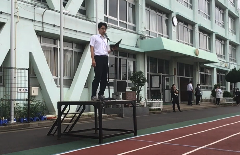
オリンピックの水泳は何種目ある?
The swimming lessons will start today. The dirty swimming pool is now clean. The members of the Exercise Committee helped us get prepared for starting the lessons. So, today, I'll talk about swimming.
First of all, I want to know how many of you like swimming lessons? Please raise your hands. Mmm. Many of the younger graders do. OK, put your hands down.
How about those who are not very good at swimming? Some.
The origin of human swimming was a long time ago. However, humans started to compete with others quite recently. After swimming became a competition, there became some official styles of swimming. I'll ask you a question. How many styles of swimming are there in an Olympic game?
1 Two.
2 Three.
3 Four.
Which answer do you think is correct? The correct answer is "Four." You know that. The styles are the crawl, the breaststroke, and the backstroke. Here is another question. The other one has a name of a creature. What is it?
1 Frog.
2 Chocho.(Butterfly.)
3 Shark.
Which one? The correct answer is "Chocho." Chocho in English is 'Butterfly.' So the fourth style is called 'Butterfly.' Do you know the style? Please check it if you don't know it. It's a difficult way to swim.
Now we have these four styles, but there were not four at first. The styles have been created one by one. Here's the last question. What is the oldest style of swimming?
Do you think the Butterfly is the oldest?
How about the Backstroke?
How about the Breaststroke?
How about the Crawl? Mmm. The largest number is this?
The answer is the Breaststroke! Do you know how to swim in the breaststroke? If you know it, you'll be able to imagine. Do you know 'doggy paddle?' Humans created the breaststroke from it.
Then, they created the backstroke, the crawl, and the Butterfly.
Lastly, I'll talk about myself. I liked P.E. very much when I was an elementary school student. However, I didn't like swimming very much. I was poor at swimming, so I didn't like the swimming lessons. Yet, I disliked that I had something I was poor at in P.E. I practiced swimming in my junior high school, high school, and even after that. Now, I love swimming! I'm happy when summer comes, and I can swim.
Do you know the proverb, "Keizokuwa Chikaranari (Perseverance makes one stronger)?" "Keizoku" means to continue. "Chikaranari" means to succeed. If you continue to make an effort, you'll be able to do many things. Some of you are poor at swimming; some are good. I hope more students will like to swim and become good at swimming through the swimming lessons this summer.
That's all for today. Thank you for listening.
令和5年6月12日(月曜日) 「動物クイズ!」 4年担任・N.S.先生 Monday, June 12th, 2023 "The Animal Quiz" by Ms. N. S., a fourth-grade teacher
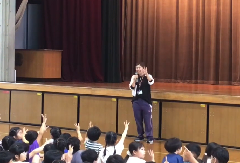
3択で問題を出します!
おはようございます。4年担任のNです。
4年生は5月に遠足で上野動物園に行きました。そこで、今日は、動物に関する豆知識をみなさんにお話しします。せっかくなのでクイズ形式でお話ししていきます。3択で出すので、指で番号を出してください。
第1問 キリンに関するクイズです。キリンの睡眠時間はどれくらいでしょう。皆さんはだいたい8〜10時間くらいですか?
1 12時間 2 2時間 3 20分間
正解は、3の「20分間」です。中休みより短いです。なぜこんなに短いのかというと、身の安全のためです。寝ていると敵から身を守れなくなってしまうので、20分間しか眠らないようです。しかも、脳が眠りの状態に入るのは1分間ほどだと言われているそうです。
ちなみに、皆さんは、キリンの鳴き声を知っていますか? なんと、「モー」と鳴くそうです。牛みたいですね。でも、めったに鳴くことはないそうで、鳴き声を聞きたい人は動物園の飼育委員さんになるか、キリンを飼うかしかありませんね。
第2問 象に関する問題です。大きい象の体重はどれくらいあるか知っていますか。皆さんは30〜50キロですか。大人の象はなんと3000〜5000キロほどあります。ではここで問題です。生まれたてのゾウの体重は何キロくらいでしょう。
1 人間の赤ちゃんと同じくらいの3キロ 2 人間の大人と同じくらいの60キロ 3 ゾウだし、赤ちゃんのうちから100キロ
正解は3の「100キロ」でした。ゾウは、赤ちゃんも大きいし重いと言うことです。
最後はカバに関するクイズです。カバは大きい口を開けてものを食べます。すいかをまるごと食べている映像を見たことがある人もいるかもしれません。では、かばはどれくらい口をひらくことができるでしょう。
1 30度くらい 2 直角の90度 3 150度
正解は、3の「150度」です。もうすこしで2直角ですね。かむ力はなんと1トンだそうです。人のことをかんでしまうことがあるそうなので、近づかないようにしてください。
今日は動物の豆知識を皆さんにお話ししましたが、知っていたことはありましたか。ほかにも動物に関する面白い豆知識があったら、ぜひクラスのみんなや先生たちにも教えてください。
これで終わります。
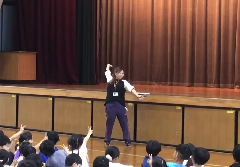
150度くらい?
Good morning! I'm N. of 4-1.
The fourth graders went on an excursion to Ueno Zoo in May. I want to talk about animals today. I will give you some quizzes. You choose one out of three alternatives and show it with your fingers.
No. 1 A quiz about a giraffe!
How long does a giraffe sleep? You usually sleep for eight or ten hours a day, right? How about a giraffe?
1 Twelve hours
2 Two hours
3 Twenty minutes
The answer is... 3! Twenty minutes! It's shorter than your break time. That's because they are in danger while sleeping. Fierce animals would attack them. Also, it's only one minute that their brains fall asleep.
By the way, do you know the sound a giraffe makes? It's "Moo!" like a cow. They seldom make that sound. You'll have to be a zoo staff if you want to listen to it, or you'll have to keep one as a pet.
No. 2 A quiz about an elephant
Do you know the weight of a giant elephant? You weigh 30 or 50 kilograms. An adult elephant weighs 3,000 or 5,000 kilograms!
So, the question is, "How heavy is a baby elephant?"
1 Three kilograms like a human baby
2 Sixty kilograms like an adult human
3 One hundred kilograms. It's an elephant!
The answer is ... 3! One hundred kilograms! A baby elephant is very heavy, too.
3 Lastly, a quiz about a hippo!
A hippopotamus eats food with its mouth wide open. Some of you may watch it swallow a whole watermelon. So, how wide can a hippo open its mouth?
1 30 degrees
2 A right angle! 90 degrees
3 One hundred and fifty degrees
The answer is ... 3! One hundred and fifty degrees! It's almost two right angles! Its power to bite is a ton! They sometimes bite humans, so do not get close to them!
I've talked about some animal characteristics. Did you know them? Please tell us and your classmates if you have other exciting animal information.
Thank you for listening.
令和5年6月5日(月曜日) 「虫歯のお化け」 2年担任T先生 Monday, June 5th, 2023 "The Ghost of Decayed Teeth" by Ms. T., a second grade teacher
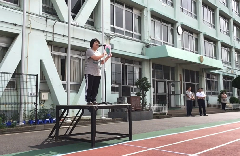
T先生
おはようございます。今日は、暑い、よいお天気の日ですが、6月、雨が多くなる季節になってきました。雨の日は皆さんは教室でどんなことをして過ごしますか。お絵かき、読書という声が聞こえてきました。教室や、図書館に行って本を読む人も多いのではないかと思います。そこで、今日は本の紹介をします。
「今日のお話、なーに?」という本です。何年か前にも一度紹介したことがある本なんですが、この本は毎日、何月何日のお話、というふうに、その日その日の短いお話が一つずつ入っている本で、毎日一つずつ読むと、1年で365個のお話を読むことができます。 では、今日は、6月5日、今日のお話の一部分を紹介したいと思います。
「虫歯のお化け」
さあ、このつづきはどうなるんでしょうか? 気になる人は2年1組の前にお話の続きをはっておきますので、歩いて見にきてください。これから先、雨の日も多くなると思うので、素敵な本とたくさん出会ってください。
これで今日のお話を終わります。
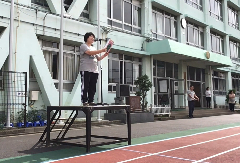
「虫歯のお化け」
Good morning! It's a warm, sunny day today. June has come, and we have the rainy season from now. What do you usually do on a rainy day at school? I hear some of you draw pictures and read books. I think you'll probably read books in the classroom or library. So, I'll introduce a book to you today.
"What's Today's Story?" is the title of this book. I once introduced this a few years ago. In this book, there are stories for each day of the year. If you read one story daily, you'll read 365 stories a year.
So it's June 5th today. I'll read some of today's story.
(Reading "The Ghost of Decayed Teeth")
Well, what will the following story be? If you are interested, come to the 2-1 classroom. I'll put the rest of the story on the wall. I hope you'll read as many good books as possible during the rainy season.
Thank you for listening.
令和5年5月
令和5年5月29日(月曜日) 「マスクについて」「交通安全について」 川中子校長、向島警察署 Monday, May 29th, 2023 "About Masks" by Principal Kawanago and "About Traffic Safety" by a police officer from Mukojima Police Station

6年生代表と挨拶
おはようございます。今日は、皆さんの命に係わる大事な話を二つ、私からと、向島警察のお巡りさんからします。
では、まず私からはマスクのことについてお話します。先週もお話しした通り、私は三吾小のみんなが、マスクをしないでいい学校になってほしいと心から願っています。みんなも知っていると思いますが、5月に入って、新型コロナウイルス感染症は前のように怖がる必要のない病気の仲間に入れられ、かかったら普通の病気と同じように、病院に行って、元気になるまで家でお休みするだけになりました。4年前に始まったコロナ騒動は、ひとまず終わりました。
先日、みんなにアンケートに答えてもらったのを覚えていますね。その結果を見たら、現在三吾小の子供たちのうち、半分の人がいつもマスクをつけていて、時々つける人と合わせると全体の約80%の人が、今でもマスクを着けているということが分かりました。皆さんは、大人の人は勝手なことを言っていると思うでしょう。これまでは、着けたくもないのに「着けなさい!」と言われて、着けることに慣れてきたら今度は「着けなくていいです。」と言われているのですからね。私自身は、自ら学び、考え、「必要な時だけ着ける、必要のない時は着けない」と決めていましたから、皆さんもご存じの通り、過去4年間もほとんどマスクを着けていませんでした。幸い、今のところコロナにもインフルエンザにもなっていません。
アンケートで皆さんにマスクを着けている理由やこれからどうするのかも聞いてみました。理由で一番多かったのは、「コロナに移るのがこわいから」でした。でも、次に多かったのは「みんながしているから」「はずかしいから」だったのです。教育目標の「自立」を思い出してほしいですね。
そして、これからもマスクを着けたいと答えている人の多くが、「コロナが0になるまで着けている」と答えていました。そこでみなさんに覚えておいてほしいのは、コロナウイルスそのものは皆さんの生まれるよりもずーっと前からあったし、これからも決してなくなりません。コロナウイルスっていうのは、風邪を引き起こすウイルスです。新型コロナウイルスはそれが変化したもの。だから、人の歴史と同じくらい前からあったし、これからもずっとあり続けるんです。コロナが無くなったらマスクを外すと考えている人は、死ぬまでマスクを着けていることになりますよ。さらに、この辺りには今は強いウイルスはほとんどいません。これまでも、学校で広まったことはほとんどありませんでした。
人間は子供の時から小さい病気やけがを経験しながら、しなやかで丈夫な体を作っていきます。それが自然なのです。いろんなウイルスが体に入って、ちょっと熱が出たり、おなかが痛くなったりするんですが、それは体が丈夫になるためには必要なことなんです。そうやって、体の中で、悪いウイルスやばい菌に負けない「免疫」という力を高めているんです。
もう一つ大事なのは、皆さんはお互いマスクをすることによって、人の顔の表情が見えない生活をしてきました。人間は、相手の表情を見て、言葉よりも多くのことを理解するんです。それができない3年間を過ごしてしまった皆さんは、心の大事な部分の成長が止まってしまっているんです。私が一番心配しているのはそこです。私は心からみんなが笑顔を見て生活できるようになることを願っています。

向島警察署のおまわりさん
Good morning. Today, I will talk about two important things that concern your life. First, I will talk about masks. Then, a police officer from Mukojima Police Station will talk about traffic safety.
As I mentioned last week, I sincerely hope you will no longer need masks. As you all know, since May, Covid-19 has been classified as a disease that does not need to be feared like before, and, if you catch it, you can go to the hospital like it's a normal illness and rest at home until you get better. The corona crisis that began four years ago has ended for now.
You remember answering a questionnaire about masks the other day. When I looked at the results, I found that half of you always wear masks, and, when combined with those who wear them occasionally, about 80% of you still wear masks. You may think that adults are saying whatever they want. Until now, you were told to wear masks even if you didn't want to, but now you are told that you don't have to wear them.
As I always learn and think independently, I decided to "wear it only when necessary and not wear it when it is not necessary," so, as you all know, I have hardly worn a mask for the past four years. Fortunately, I haven't had covid-19 or influenza so far.
I also asked you in the questionnaire why you want to wear masks and what you will do in the future. The most common reason was "because I'm afraid of getting infected with Covid-19." However, the following most common reasons were "because everyone else is doing it" and "because it's embarrassing." Please remember our educational goal, "Independence." Also, many who answered that they want to continue wearing masks said they are wearing them "until coronavirus becomes zero."
I want you to know that the coronavirus has existed for much longer than your life and will never disappear. The coronavirus is a virus that causes colds. The new coronavirus is a mutated version of it. Therefore, it has been around for as long as human history and will continue to exist forever. So, if you think you will take off your mask when the coronavirus disappears, you will have to be wearing a mask until you die.
Moreover, there are hardly any strong viruses around here now. There have been few cases of transmission at school so far.
Humans create supple and strong bodies while experiencing minor illnesses and injuries from childhood. That's natural. Various viruses enter our bodies and cause a slight fever or stomachache, which is necessary for the body to become strong. In this way, the body is strengthening the power of "immunity" that defeats viruses and dangerous bacteria inside the body.
Another important thing is that you have been living without seeing the facial expressions of each other by wearing masks. Humans understand each other by looking at each other's facial expressions more than hearing words. You spent three years unable to do so, and an essential part of your heart has stopped growing. That's what I'm most worried about. I sincerely hope that everyone can live seeing each other's smiles.
令和5年5月22日(月曜日) 「子どもの権利と自分を幸せにする魔法のコトバ」 家庭科・みどり担任 SA先生 Monday, May 22nd, 2023 "Children's Rights and The Magic Words to Make You Happy" by Ms. SA, Home Economics teacher
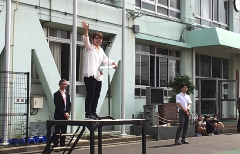
SA先生
おはようございます。今日は、皆さんに二つのことについてお話しします。一つ目は「子供の権利」というお話で、もう一つは「自分を幸せにする魔法のコトバ」です。
まず、子供の権利についてです。「子供の権利」って聞いたことある人? 聞いたことのある人もいますね。大きく分けて、4つあります。
1「生きる権利」
2「育つ権利」
3「守られる権利」
4「参加する権利」
これは、皆さんが自分が自分らしく生きていける、成長していけるという権利で、それを大人はサポートしていく、というのを約束したのが子供の権利条約といいます。
でも、みんなが好き勝手にしていいということではありませんね。あなたの思いや願い、気持ちが大切なのと同じように、友達にも大切にされる権利があります。皆さん一人ひとりが自分の好きなことや、自分の気持ちを大切に生活していってほしいと思います。
次に、自分を幸せにする魔法のコトバについてお話しします。まず、言ってみてください。「あー、幸せだなー!」
どんなことでも、当たり前のことなんて一つもありません。目覚められたこと、大好きな人たちが元気でいてくれること。普通のことが、本当に幸せなことなんですよ。だから「あー、幸せだな。」って一日に10回でも100回でも言ってみてください。そうすると、幸せが心にたまってきます。幸せがたまってくると、本当に毎日幸せだと感じられるようになります。ぜひ、つぶやいてみてください。
今日は子供の権利についてと、自分を幸せにする魔法のコトバについてお話ししました。これでお話を終わります。
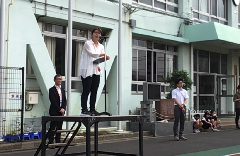
「あー、今日も幸せだなあ!」
Good morning! Today I'll talk about two topics. One is about "Children's Rights," and the other is about "the magic words to make you happy."
So, about "Children's Rights." Have you ever heard of "Children's Rights?" I see some of you raising your hands. There are four principal rights for children:
1 The right to live
2 The right to grow up
3 The right to be protected
4 The right to participate
These are your rights to be as you are and grow up, and adults must support you.
However, these rights do not mean that you can do anything you like. Your thoughts, wishes, and feelings must be treasured, and so must the others' thoughts, wishes, and feelings. I want you to go on living with cherishing your feelings and likes.
Next, I'll talk about "the magic words to make you happy." First of all, let's say the magic words. "How happy I am!"
Everything is no ordinary thing; to wake up in the morning and see your loved ones well. Those ordinary things make you happy. So, please say, "How happy I am!" ten or a hundred times a day. Then happiness will pile up in your heart, which will make you happier. Please try it!
I've talked about "Children's Rights" and "The Magic Words to Make You Happy" today. That's all. Thank you for listening.
令和5年5月15日(月曜日) 「絵をかく、かく、かく」 図工専科・M先生 Monday, May 15th, 2023 "The Painter Who Painted A Blue Horse Book" by Mr. M., the Art and Crafts teacher
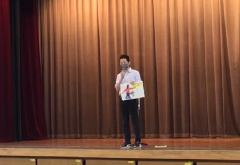
「絵をかく、かく、かく」
今日は私からお話しします。
去年の私の話は覚えていますか? 去年はまだ全校朝会はみんなで集まれなかったので各教室で行いましたね。私は本の読み聞かせをしました。今日のお話も本に関係するお話です。3年生から6年生の人にクイズですが、この絵に見覚えがあるという人、手を挙げてみてください。たくさん手が上がっていますね。この絵はどこに貼ってあったか、知っているという人はいますか。図工室の扉に、去年から貼ってありました。これは絵本の1ページなんですが、題は「絵をかく、かく、かく」といいます。この本を書いた人は知っていますか?
何人かいますね。読んだことあるという人もいると思います。この絵を知らない人でも、こっちは知っているかもしれませんね。(「はらぺこあおむし!」)とても有名な絵ですね。
エリック・カールという人が書きました。たくさんの絵本を、亡くなるまで書いたカールさんですので、いろいろな種類の絵本があります。この「絵をかく、かく、かく」ですが、あらすじはどんなお話でしょう。主人公の男の子がいます。この子は絵が大好きで、絵描きになりたいと言ってたくさんの絵を描きます。ページをめくるごとに、たくさんの絵が出てくるんですが、この子は動物の絵を描くのが大好きです。例えば、馬をかきます。青い馬だったり。ワニを書きます。ピンクのワニだったり。シロクマを書きます。黒いシロクマだったり。あれ、シロクマって黒かったっけ? 最後には水玉模様のカラフルなロバまで出てきます。でも、みんなの知っているロバって、水玉模様だっけ? ちがうね。実はこの男の子のモデルになった絵描きさんがいて、フランツ・マルクさんという昔昔の絵描きさんがいました。その方は動物が大好きで、動物の絵をたくさん描きました。この絵本に出てくる男の子みたいに、青い馬、黄色い牛、本当の色とはちがう色だけど、自分の描きたいと思った色で動物たちの絵をたくさん描いた画家さんです。フランツ・マルクさんは、たくさんの動物の絵を描いていたんですけど、作品の数はそんなにおおくありません。なぜなら、戦争といって、国と国との争いごとに兵隊さんとして招かれてしまったので、本当は絵をたくさん描きたかったけれど、残念ながら戦争でなくなってしまいました。これはそういう絵描きさんをモデルにした絵本です。なんでカールさんはこの絵本を描こうとおもったのか。カールさんが子供のころにも、まだ戦争の面影があったそうです。絵を自由に描くっていうのが許されていなかった。「青い馬なんかいるわけない。カラフルなロバなんているわけない。そんなものは芸術じゃない。」そういう時代でした。そんなときにカールさんは、フランツ・マルクさんの絵のことを知って、「色って、こんなに自由に塗っていいんだ。」と子供の時に思ったそうです。カールさんは大人になってから、こどもの時に見たカラフルな動物たちの絵のことを思い出して、この絵本を描いたそうです。
私はとてもこの絵本が好きです。自分の描きたい色で、描きたいように絵を描くってこんなに楽しいんだよ、素晴らしいんだよ、てことが描かれているこの絵本が大好きで、図工の授業もそんな風にしたいなと思って、図工室の扉にところに貼ってあります。今朝、三吾小の図書館で探したら貸し出し中で見当たらなかったんですが、興味をもった人はぜひ読んでみてほしいと思います。今週は土曜日までありますので、怪我なく元気にすごしてください。これで私のお話を終わります。
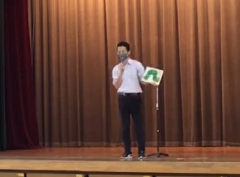
はらぺこあおむし
I'll talk to you today.
Do you remember what I told you last year? We couldn't have face-to-face assemblies yet last year. I read a book for you. Today I'll talk about a book again.
First of all, have you ever seen this picture? I can see many students are raising their hands. Where did you see this picture? Yes. It is on the door of the Art and Crafts room. It is a page of one picture book. The picture book title is "The Artist Who Painted A Blue Horse Book." Who created this picture book? I think some of you have read it. How about this picture? You may know it. ("The Very Hungry Caterpillar!") Yes. It's a very famous picture. These books were made by Eric Carle. Eric Carle made a lot of picture books before he passed away. What do you think is the content of "The Artist Who Painted A Blue Horse Book?"
There's a boy who is the main character of the story. He likes painting very much and wants to be a painter. He paints a lot of pictures. As we turn the pages, we can see many images of animals. For example, he paints a horse, which is blue; a crocodile, which is pink; a polar bear, which is black. Is a polar bear black? And he painted a donkey, which is colorful and polka-dotted. Is a donkey polka-dotted? No, it isn't.
Long ago, there was a painter who was the model of this boy. His name is Franz Mark. He liked animals very much and painted a lot of images of animals. He painted animals of different colors, like the boy in the story. He colored those animals as he liked.
Franz Mark painted many pictures, but there are few works of his. Why? That's because there was a war, and he had to become a soldier. He wanted to paint more pictures, but unfortunately, he died in the war. This picture book is about such a painter.
Why did Eric Carle make this book? When he was small, there remained the atmosphere of war. People could not paint freely. "There's no blue horse! No colorful donkey! These are no art!" It was a time like that. Carle came across the paintings of Franz Mark and thought, "I can use colors freely like his paintings!" As he grew up, he made this picture book after the memory of Franz Mark's colorful animals.
I love this book because it tells me we can paint as we like and color as we want. I want my class to be like that, so I put this picture on the room door.
As I looked for the book in our library, someone borrowed it. I want you to read the book, too.
We have a Saturday Open day this weekend. Be well and take care of yourselves. That's all for today. Thank you for listening.
令和5年5月8日(月曜日) 「新型コロナウイルス感染症のとりあつかいについて」 白石副校長先生 Monday, May 8th, 2023 "How to Deal with COVID-19 from Today" by Vice Principal Shiraishi
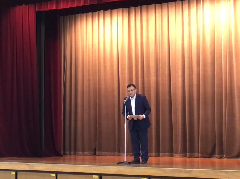
白石副校長先生
おはようございます。今日は、副校長先生が話をします。
今日は、コロナウイルス感染症の取扱について話をします。
ニュースでもたくさん報道されていたので、知っている人もいるかと思います。
今日から新型コロナウイルスの感染症法上の位置付けが、5月8日に「2類相当」から「5類」に引き下げられます。これによって、今までの新型コロナウイルス感染症に対しての考え方が変わります。
もし、新型コロナウイルス感染症にかかっても「発症の翌日から5日間で、なおかつ症状が軽快後1日経過するまで」という方針を示されていて、インフルエンザと変わらない扱いとなります。
今日から、健康観察カードがなくなります。
ちなみに、同居家族などが「濃厚接触者」として、感染者と同様の行動制限を求められることはなくなります。身近な人が感染すれば、自分も感染しているリスクが高いことは変わりませんが、あくまで各自の判断になります。
国や自治体から求められる制限はなくなりますが、感染リスクがなくなるわけではないので、引き続き各自で対策をしましょう。厚労省の専門家会合のメンバーは、感染対策として「5つの基本」を提言しています。
(1)体調不安や症状がある場合は自宅療養や医療機関を受診
(2)その場に応じたマスクの着用やせきエチケットの実施
(3)3密回避や換気
(4)手洗いや手指消毒
(5)適度な運動と食事
「ソーシャルディスタンス(2メートル以上)」などという言葉もよく使われましたが、こうした具体的な指標は示されていません。各自が状況に合わせて基本的な対策を行うことになります。
マスク着用は3月13日から「個人の判断」となっていましたが、引き続き同様です。これからの季節、とても暑くなりますので、自分の体調に合わせて、自分で考えて、取り外ししてください。しかし、体育や休み時間、体を動かすときには、マスクは外すようにしてください。熱中症にかかるほうがとても怖いです。
感染症対策として、各自 状況に合わせて というのがキーワードとなります。その場に合わせて適切な行動がとれるようにしていきましょう。
よく寝て、よく食べて、よく運動して、健康に、楽しく学校生活を送ってほしいと思います。
お話を終わります。
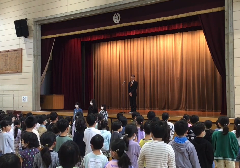
6年生代表
Good morning, everyone. Today the Vice Principal will talk to you.
I'm going to talk about how to deal with Covid-19 from today. Many of you would know about the change because you have probably heard it on the TV news. Japan entered its post-pandemic phase today, officially downgrading COVID-19 to a status on par with the seasonal flu and doing away with a range of coronavirus measures to reclassify the disease from one similar to Class 2 to Class 5 under the Infectious Diseases Control Law. That will change the way we deal with COVID-19. If you catch it, you must stay home for five days after the disease outbreak and a day after getting well. You don't need to use your Health Check Card from today. The behavior restrictions for close contact persons in a family will also be canceled. However, you'll still be likely to be infected if your family catches it. You must decide what to do yourself.
Although the restrictions are canceled, the risk of infection will go on. We must protect ourselves. The Ministry of Health, Labour and Welfare has given 'The Five Basic Recommendations.'
1 Stay home and see a doctor when you feel sick or have symptoms.
2 Be careful of mask-wearing when needed and coughing etiquette.
3 Stay out of three Cs and ventilate rooms.
4 Wash or disinfect your hands.
5 Proper exercise and diet.
You remember 'Social Distancing.' This time they didn't give such practical instructions. We can decide to take preventive actions according to the situation.
Mask-wearing has been a choice since March 13th, and it will be the same. You decide whether you should wear a mask or not. However, it'll be getting warmer and warmer. You should remove your mask when it's hot, especially in P.E. class and when you play on the grounds. Heat stroke is much more dangerous.
The Keywords for the change are 'decide by yourself' and 'according to the situation.' Let's take proper action according to TPOs.
Sleep well, eat well, exercise well. I want you to stay healthy and have a good school life. That's all for today.
令和5年4月
4月24日(月曜日) 「自分たちの学校を楽しくする」 川中子校長 "To Make Your School More Fun By Yourself" by Principal Kawanago

6年生代表
さて、これを見てください。今日の6時間目から4年生以上のクラブ活動が始まります。三吾小のクラブ活動は、初めから決まっているのではなく、児童が自分たちでやりたいクラブを考えて、仲間を集めて、一定の条件をクリアできるとクラブが発足します。
実は、これは今の6年生が5年生だった時、自分たちで新しいクラブを作りたいと考えて、仲間を集めるために作った宣伝のポスターです。代表の人たちが校長室に来て、クラブのポスターを校内に掲示させてほしいと頼みに来ました。私は、ポスターは誰が何枚くらい作るのか、どこにはるのかなどいくつか質問をしました。頼みに来た人たちは相談して、こうしたいという希望を話しました。それなら、ポスターをはってもいいですよと許可しました。それから数日後、その人たちがもう一度校長室に来て、このポスターを校長室の壁にはらせてもらえないかと持ってきたのです。とてもよくできているので、びっくりしました。校長室の壁には、いろいろと貼ってありますから、空いているところがあったらどうぞ、というと、喜んで壁に掲示していきました。
後日、担当の三浦先生に聞くと、その人たちの作りたかったクラブは、見事仲間も集まって発足できることになったそうです。よかったですね。これからの活動も自分たちでしっかり進めていってほしいと思います。
今年度は、学校は、皆さんの主体性を大切にしたいと考えています。今のクラブのお話のように、自分たちで学校をもっといいところに、楽しいところにできるよう、考えてほしいと思います。例えば、委員会活動。どうすればもっと楽しい学校、みんなが安心して生活できる学校にできるか。学校の行事。体育学習発表会は、どんなことをやってみたいか、展覧会はどんなものにしたいか。みんなの意見を取り入れながら作っていきたいと思います。
話は変わりますが、今日皆さんにお話ししておきたいことがもう一つあります。それは、この第三吾嬬小学校の3階にある学習室「みどり」という教室についてです。
以前、三吾小の子で、教室で多くの友達と一緒に過ごすのがつらくなってしまって、教室にいられなくなってトイレにこもってしまったことがありました。そんなこともあって、三吾小にはたくさんの人がいますから、時々、一人になりたくなったり、イライラしたりしてみんなにあたりそうになったりするときは誰にでもありますよね。そんなとき、静かにきもちを落ち着けられるような場所があるといいなと、3年前に、先生たちで話し合って作ったのが学習室「みどり」です。名前の「みどり」には、気持ちをフレッシュにさせる、元気にさせるといった願いが込められています。
これまで「みどり」には、ちょっとみんなから離れていたい人や、学校になかなか登校できない人など、様々な人が過ごしていました。今年は、学習室「みどり」にも担任の先生をつけることにして、榊原先生が毎日1,2時間、みどりにいてくださいます。
みどりは、三吾小の子なら誰でも使えます。保護者の人と一緒に使っている人もいます。使うときのルールは、担任の先生に必ず言ってから行く、ということだけです。
皆さんに、特に教室の近い5年生にお願いですが、みどりに来ている人たちは、たいてい、「そっとしておいてほしい」人たちです。用もないのに入ったり、外でうるさくしたりしないように気をつけてもらえるとうれしいです。私は、皆さんの教室と同じように、学習室「みどり」も大切に思っています。今日は、それを皆さんに伝えておきたかったのです。
これで今日のお話を終わります。

6年生の作ったポスター
Good morning, students! Look at this!
Club Activities this school year will begin today for the fourth and other upper graders. We do not have any clubs settled beforehand. Students create the clubs they want, gather members, and a new club will be founded if the plan meets some conditions.
This is an advertisement poster for a new club that some sixth-grade students wanted to make when they were in the fifth grade. The representative students came to my office and asked me if they could put the posters in the school. I asked them: "How many posters will you make?" "Where do you want to put them on?" They talked it over and told me their hope. I allowed them to do it. A few days later, they came to my office again with a poster and asked me if they could put it on the wall of my office. I was surprised by the poster, which was very good. I told them, "There are many things on the wall, but if you can find the place, you can put it on." They looked happy and put it on the wall.
Later, Mr. M, who is in charge, told me their club was founded with enough members. I'm glad to know that. I hope they will manage the club well by themselves.
We, teachers, hope you are proactive. Like the episode today, I want all of you to make your school life better and more fun. For example, how about the students' committees? Think about how to make the school safer and more comfortable. How about the school events? What do you want to do at your sports festival and the art exhibition? We want to create them with your ideas.
By the way, I have one more thing to talk to you about today. It's about the Study Room "Midori" on the school's third floor.
There was a girl who suffered from being in her classroom with her classmates and kept herself in a restroom. Our school is big, so you know sometimes anyone may want to be alone or feel irritated and afraid of bothering classmates. We thought we needed a place for such students in our school. Three years ago, we discussed it and made a special classroom, "The Study Room MIDORI." The name, 'Midori (Green),' means to refresh and be energetic, which is our hope for students who use it.
Since then, it has had various students visit who felt difficulty in their classrooms or couldn't easily come to school. Also, I put a teacher in charge of the room this school year. Ms. S stays one or two hours a day there.
Anyone in our school can use "Midori." Some students use it with their parents. Only one regulation is needed: You must tell your homeroom teacher when you want to use it.
Also, I ask all of you a favor, especially the fifth graders whose classrooms are close to "Midori." Those students who are in "Midori" want to be alone. So, leave them alone. Do not bother them. It's as precious as other classrooms. Remember that, please.
That's all for today. Thank you for listening.
令和5年4月17日(月曜日) 「三吾あいことば 〜 自分で、自分から」 川中子校長 "The San-Azu Watchwords" by Principal Kawanago

はじめに対面式を行いました
1年生の皆さんを迎えての初めての朝礼です。今日は1年生も加わったので、三吾小で大切にしてる「三吾あいことば」についてお話しします。
「三吾あいことば」には「はじまりかまえ」「時まもり」「まっすぐせすじ」「聞き目聞き耳」「あいさつえがお」「へんじがえし」「ふわふわことば」「右しずか」「かかとそろえ」「おたすけこえかけ」の10個のあいことばがあります。これは、皆さんが学校で他のお友達と一緒に過ごす上でとても役に立つ「知恵」の言葉です。これらのことを、自分で、自分から守るとすれば、皆さんは立派な人になれます。
大事なのは、自分で考えて行うことです。例えば、「右しずか」というあいことばがあります。これは、学校の廊下や階段では、右側を静かに歩きましょう、という意味です。よく、校長室の前の廊下を走っている人がいますね。校長室の前には、「右しずかちゃん」も皆さんを見守っています。どうして、右側を静かに歩いた方がいいのですか? 右でも左でもいいじゃありませんか。走ってもいいじゃありませんか。どうして、右側を静かに歩こうというのでしょう? 近くの人と話してみてください。
そうですね。そうやって、まず、自分で考えてみる。そして、ああ、これがいいのだと思ったら、自分でそのようにできるように努力する。そうすると、自分だけでなく、他の人にとっても安全で安心な学校にすることができますね。
先生や、他の人に言われたからする、のではないのですよ! 自分で考えて、正しいとおもったことができるようになることが大事なのです。自分のすることは、自分が決める。「自分で、自分から」です。
三吾あいことばは、生活の知恵です。他のあいことばについても、クラスでみんなとお話ししてみてください。これで終わります。

6年生代表あいさつ
This is the first morning assembly with the new first-grade students. Five hundred and fifty-three students are here. Please get along with each other. Today I'll talk about the San-Azu Watchwords, which we treasure in our school.
"The San-Azu Watchwords" are ten watchwords: 'Hajimari Kamae,' 'Tokimamori,' 'Henjigaeshi,' 'Fuwafuwakotoba,' 'Migishizuka,' 'Kakatosoroe,' and 'Otasukekoekake.' These are the words of wisdom for the students to have a good school life together. You'll be great people if you practice the watchwords yourselves.
The important thing is that you think and act independently. For example, we have 'Migishizuka' in the San-Azu Watchwords. It means that we should walk silently on the right side of the corridor and stairway. I often see students running in front of my office. You see 'Migishizuka-chan' in front of my office watching you. Why should we walk silently on the right side? Isn't it all right to walk both sides? Isn't it OK to run? Why does the watchword say so? Now, please talk about your ideas with your neighbors.
All right. It's important to think by yourself first, and if you think, "Yeah, this is right!" you try to act by yourself. Then, not only you, but also other students will be able to live a safe and comfortable school life.
It's NOT that you do it because teachers tell you to. The important thing is to become a person who can think and act independently. You choose what you do yourself. "From yourself, by yourself." Right?
The San-Azu Watchwords are the wisdom of life. Please talk about other watchwords with your classmates, too.
That's all for today.
令和5年4月10日(月曜日) 「開校記念日について」 川中子校長 Monday, April 10th, 2023 "About the Anniversary of the Founding of The School" by Principal Kawanago

6年生代表あいさつ
おはようございます。新しい年度が始まりました。新しいクラスの人とはもう友達になれましたか? 新しい先生や友達と、お互いによくわかり合えるようになるといいですね。
さて、今日は4月10日月曜日ですが、皆さん。今週の木曜日は何の日か知っていますか?
今週の木曜日、4月13日は、第三吾嬬小学校の開校148周年の記念日、つまり学校の誕生日です。
第三吾嬬小学校は、明治8年に誕生しました。明治8年というのは、皆さんが好きな鬼滅のお話のたんじろうたちの生きていたよりももっと前のことで、日本ではお侍さんが国を治めていた江戸時代が終わってからまだ8年しか経っていなかったころのことです。このあたりは、江戸の米所で、一面田んぼや畑だったそうです。この、八広のあたりは、曲がりくねった路地が多く、慣れない人はわかりにくいところですが、それも当時このあたりが田んぼだったことの名残だそうです。
新しい時代になって、これからは生まれではなく、一人一人が勉強して自分のなりたい職業に就くことができるようになりました。これからは、学問が大事だと考えた村の人たちが自分の子供たちに教育を受けさせるために、みんなでこの地に学校を作ろうと考え、教育者の江幡先生という方をお招きして学校を開いたのが始まりだそうです。最初の児童数は29人だったそうです。
それから148年間の間には、いろいろなことがありました。東京は、今から100年前に関東大震災という大きな地震の被害を受けたり、昭和20年には太平洋戦争で大空襲を受け、学校も焼けてしまったりしたそうです。そういう苦しいときでも、この町の人たちは、学校を守るのだと力を合わせ、他の学校にも先んじて復興を成し遂げたと言われています。
先日の卒業式を終え、これまでに14,431名の人がこの学校を巣立っていきました。今年は75名の新入生を迎え553名でスタートしています。この墨田区でも最も歴史のある学校に皆さんは通っているわけです。そして今、私たちは、新しい未来に向けて、「自立 自ら学び、考え、行動する人」「共生 思いやりをもち、共に生きる人」「健康 しなやかで丈夫なこころとからだをもつ人」の教育目標の達成を目指して学んでいます。校歌にも「栄えの歴史を受け継いで 守れ校風 自立の誓い」とあるように、自ら学び、考え、行動できる人になるようがんばりましょう。
これでお話を終わります。

すがすがしい朝です
Good morning, students! The new school year has just begun. Have you made new friends in your new class yet? I hope you will understand each other soon.
Well, today is Monday, April 10th. What day do you know this Thursday is? Thursday, April 13th, is the 148th anniversary of the school's founding, our school's birthday!
Daisan-Azuma Elementary School was founded in 1875. 1875 was earlier than the time Tanjiro in "Kimetsu no Yaiba" lived. It was only eight years after the Edo Period when Samurais governed the whole nation. Rice fields spread around this area in those days. There are many narrow paths in Yahiro now. They were the ridges between rice fields.
A new era began, and people became able to choose their occupations by studying, not by their nativity. That's why the villagers thought education was important. They built a school for their sons and daughters and invited an educator, Mr. Ebata. Only twenty-nine students were in the school at the foundation.
Many things have happened during these 148 years. There were a huge earthquake called the Kanto Great Earthquake about one hundred years ago. In 1945, they had the Tokyo Great Raid in WWII, and the school burnt down. Through those hard times, the people in this town stood up bravely and rebuilt the school.
We had a graduation ceremony in March. Fourteen thousand four hundred thirty-one students have graduated from our school. We had seventy-five new students, and our school starts with 553 students this school year. You are learning at the most historic school in Sumida City. Now we learn to achieve our school's educational goals: "Independence - A person who learns, thinks, and acts independently," "Living Together - A person who lives together with empathy," and "Health - A person who has a supple and strong mind and body." Our School Song reads, "With the glorious history, let us save the school tradition and the oath of Independence." Let's try our best to be a person who learns, thinks, and acts independently.
That's all for today. Thank you for listening.
令和5年4月6日(木曜日) 「令和5年度始業式 校長式辞」 Thursday, April 6th, 2023 "The Opening Ceremony Address"
着任式
おはようございます。春休みが終わって、皆さんは一つ学年が上がりました。進級、おめでとうございます。今日は3名の転入生と、この後75名の新1年生が三吾小の仲間入りします。令和5年度は全校児童553名でのスタートです。
令和5年度を始めるにあたり、私から二つのお話をします。
一つ目は、私たちの学校教育目標についてです。みんなで教育目標を言ってみましょう。自立 自ら学び、考え、行動する人
共生 思いやりをもち、共に生きる人
健康 しなやかで丈夫なこころとからだをもつ人
今年も皆さんにはこの三つの柱を、いつも意識した生活をしてほしいと思います。そして、特に今年も、「自立 自ら学び、考え、行動する人」を重点目標として、皆さんが主体的に生きることができるようになってほしいと願っています。「自分で、自分から」です。今年は、学校のことを考える際に、いつも皆さんの意見を聞きながら進めようと思っています。皆さんと一緒に、新しい学校を作っていこうと思っていますので、皆さんもどしどし意見を寄せてください。今までよりも、もっと楽しい学校にしていきましょう。
もう一つは、今日からの学校生活で今までと変わったことについてお話しします。
3月まで、学校では皆さんにマスクをつけておいた方がいいですよ、という話をしてきました。もちろんしなくてもいいですよ、というお話もしてきたのですが、4月からはとうとう、学校ではマスクはつけなくてよい、ということが決まりました。この3年間、皆さんは、体育の時以外はマスクをした生活、給食も前を向いて黙って食べる生活をしてきましたね。このかんに、新型コロナウイルス感染症のことも大分分かるようになってきて、現在東京でも感染者はほとんどいなくなってきました。世の中全体で、今までよりも、自然な生活にもどしていこうということになったのです。マスクは、必要な人が必要な時につければよいものです。ちょうど、傘みたいなものです。雨が降っているときは傘を差せばぬれずにすみますが、雨がやんだのにいつまでも傘を差している必要はありませんね。
これまでずっとマスクをしてきたので、ないと怖いと思ってしまう人もいると思います。怖いうちはつけていてもいいですよ。ただ、この3年間のマスクの生活が続いて、みんなが顔の表情が見えない状態が続いて、私たちの心が疲れてしまいました。お医者さんも、今はコロナにうつるよりも、そちらの方が心配だと言い始めています。私は、一日も早くみんなが先生やお友達の笑顔を見ながら、楽しく生活ができるようになるといいなと、心から願っています。私は自信をもって言います。マスクを外しても大丈夫ですよ。不安に思っている人は、これから、おうちの人や先生、友達とも、ゆっくり話をしていきましょうね。
それでは、今日から始まる学校生活を、元気に楽しいものにしていきましょう。これでお話を終わります。
始業式は雨のため放送
Good morning, students! Spring Vacation is over, and you've become one grade older. Congratulations! We have three new students who have moved to our school and will have seventy-five new first-grade students. Our school starts with 553 students this school year.
Today I'll talk about two things on the opening day of the new school year.
First, I'll talk about our school's educational goals. First of all, let's say them now!
Independence - A person who learns, thinks, and acts independently
Living Together - A person who lives together with empathy
Health - A person who has a supple and strong mind and body
I want all of you to live your school life with these goals. Especially this school year, too, we lay stress on "Independence." I want you to be proactive. I want to remake our school culture this year by hearing your ideas. Let's make our school better and more pleasant.
Secondly, I'll talk about the change in our school life. Until March, we were told to put a mask on our faces. They finally decided that we didn't have to wear a mask anymore. These past three years, you spent your school life with masks and 'silent school lunches.' However, we humans have learned about COVID-19 and decided to make our life normal, as before.
Only those who need a mask should wear it when needed. It's like an umbrella. We use an umbrella when it is raining to avoid getting wet. When it stops, we don't need an umbrella.
However, I know many of you feel scared to take it off. While you're scared, it's OK to wear your mask. Yet, during the past three years of wearing a mask, we couldn't see other people's expressions, which weakened our spirit. Many doctors have begun to say it is more dangerous than catching COVID-19. I wish the day would come as soon as possible when we can see each other's smiles and become happy. So, I say with confidence, "It's all right to take off your masks!" If you are afraid, talk about it with your parents, teachers, and friends.
So, let's make our new school year happy! That's all for today. Thank you.